We’ve now lived in our 1916 Toronto house for more than 40 years, making us one of the old-timers on the block. When we moved in back in 1983, there was a long driveway leading to a ramshackle garage which was too small for modern cars but just right for a family of raccoons who did not take kindly to being evicted. In fact, most of the driveway was too narrow for a car so we decided to create a side garden halfway down it in place of the last 40 feet of asphalt, bisected by a winding path behind a pretty arched gate. That was 1988. At the time, the publisher of Canadian Gardening magazine lived in the house behind me and thought my gate would make a good cover for the very first issue of the magazine, launched in 1990 and published for 25 years, finally closing down in 2015. Apart from writing stories for three of its editors in that quarter-century, they also became very good friends. And as you see, back in 1988 I was growing impatiens in the shade, as were most gardeners.

A few years later, I wrote a story on the gate and garden for Fine Gardening magazine, title page below. In the article, I tallied up the costs: $960 US for the gate and fence panels (the gate incorporated a “see-through” made from an old brass heating grate we found while renovating the house); $500 for the path, including breaking up and removing the asphalt as far as the driveway’s original limestone grit and laying down concrete pavers; and a load of topsoil and plants to bring the total to about $2,000. I cannot imagine doing this today for less than $10,000, likely more. Only 9-1/2 feet separated our house from the neighbour’s fence, so the path took up 3-1/2 feet with 3 feet of garden on either side. To complicate matters, a black walnut tree (Juglans nigra) that had likely been small when our house was built during the First World War was now a hulking 70-footer, its big trunk straddling the property line, the allelopathic juglone secreted by its leaves and roots toxic to certain plants growing underneath it.
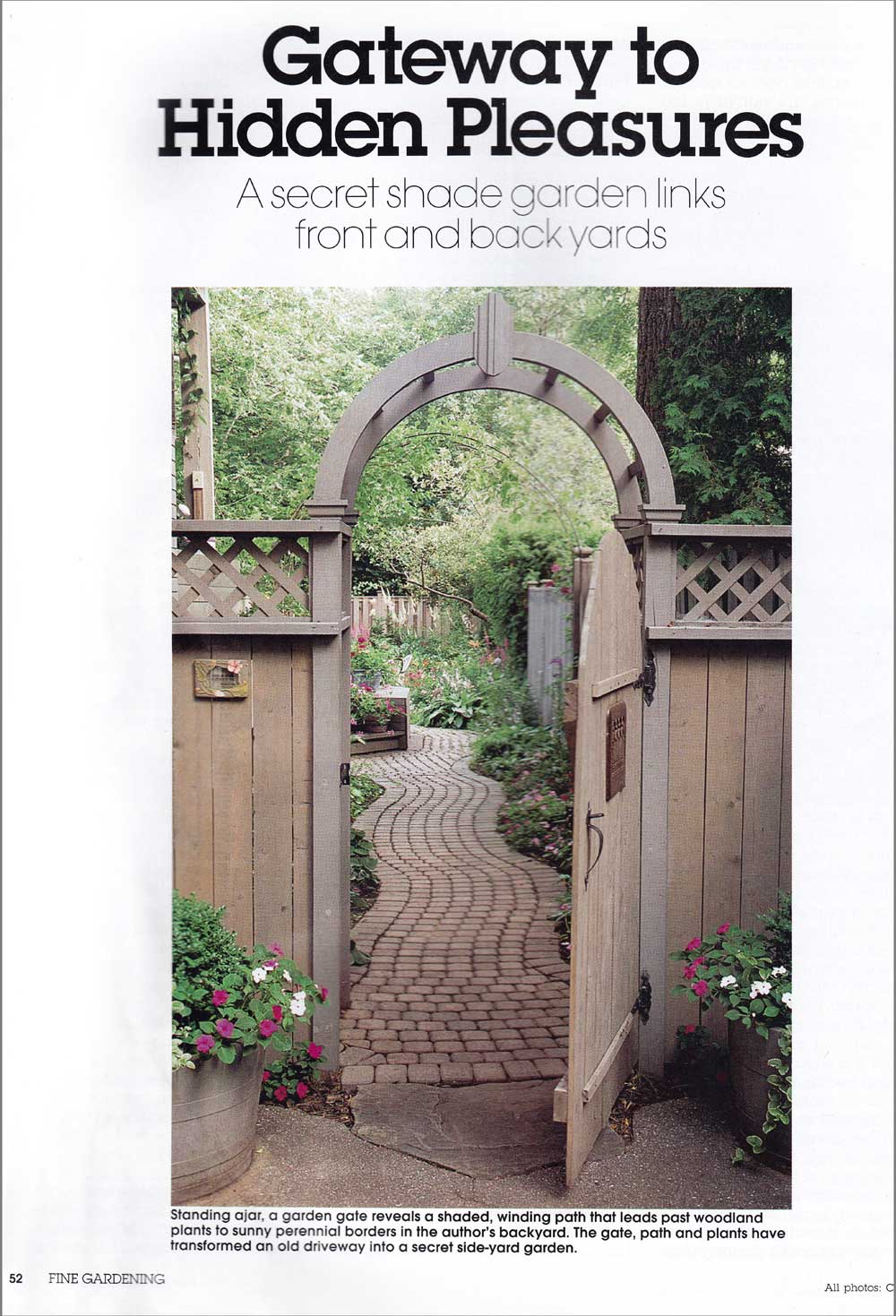
As the years passed, the walnut tree needed periodic pruning and cabling. On one occasion, an arborist working in the branches above dropped a heavy branch onto the gate and broke the arch. But even without it, the gate added a certain flair to the house – I even gave it a big Christmas wreath for several years. I had planted the two half-whiskey-barrels flanking the gate with ‘Green Velvet’ boxwood shrubs (a Canadian introduction) around 1990, though I was warned they wouldn’t survive the first winter. Not only did they survive that winter, they lived in the barrels with no care except an occasional summer watering and shearing for more than 30 years! And in the photo below you can see the first tendrils of a bird-seeded Boston ivy (Parthenocissus tricuspidata) beginning to climb the fence panel at right.
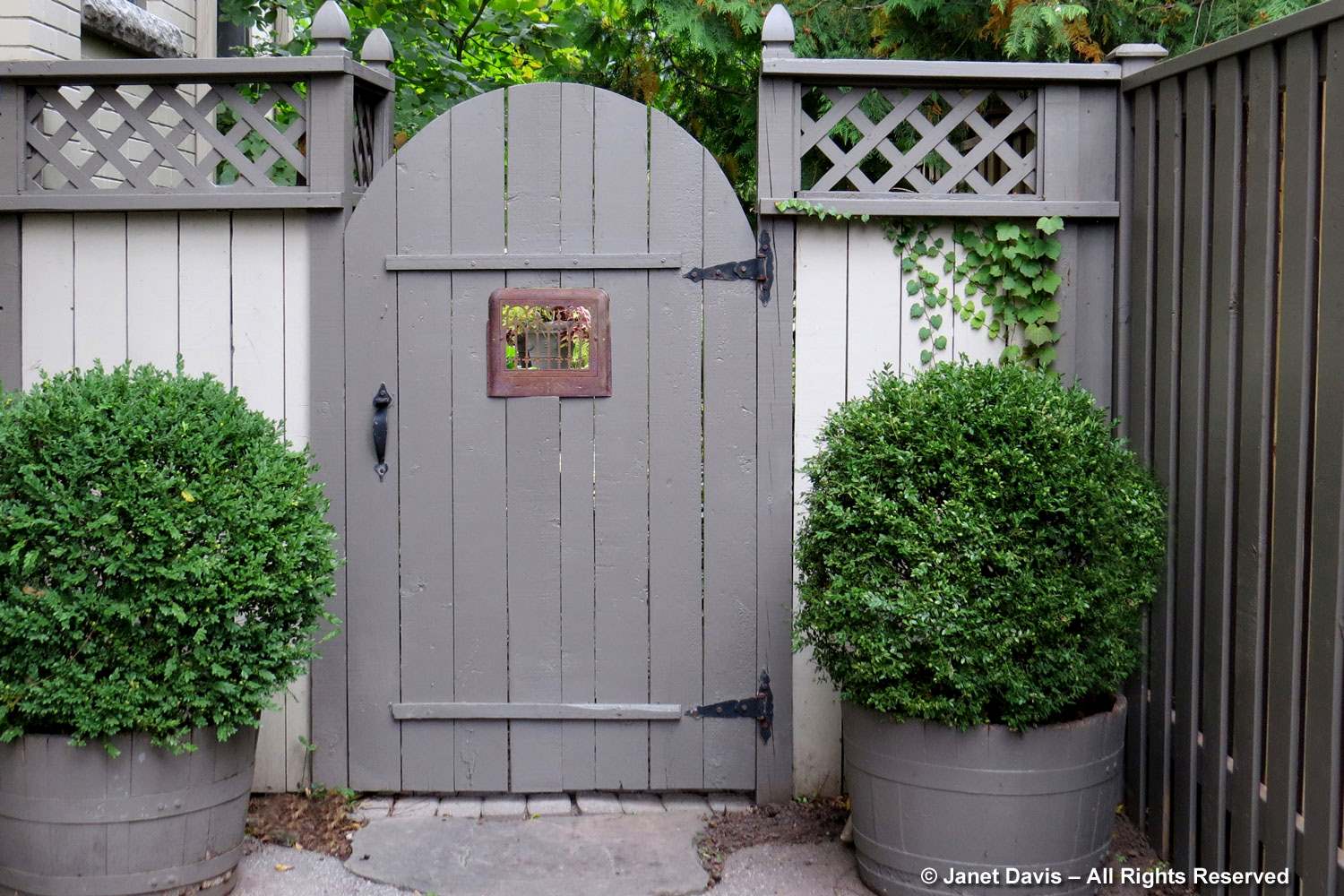
In 2010, I designed and had built a screen to hide the recycling and trash containers, staining it to match the gate and house. (You can see the long crack forming in our old driveway here.)
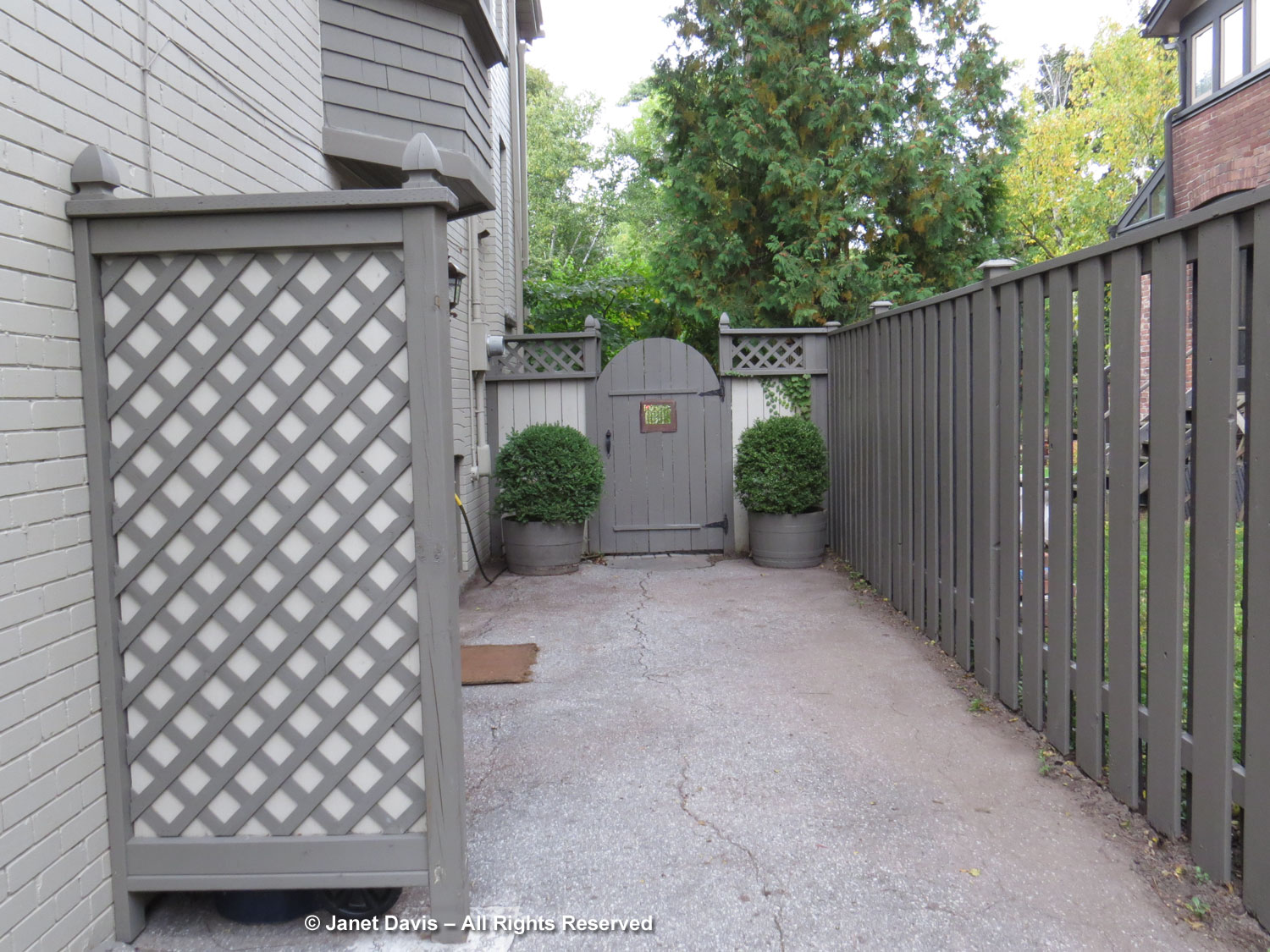
I had designed a driveway utilities screen for a gardening client in the 1990s, so while I had contractors at the house rebuilding our sundeck, I thought it was a good chance to utilize the design myself. Because as much as I approve of recycling, I can’t stand the look of plastic bins.
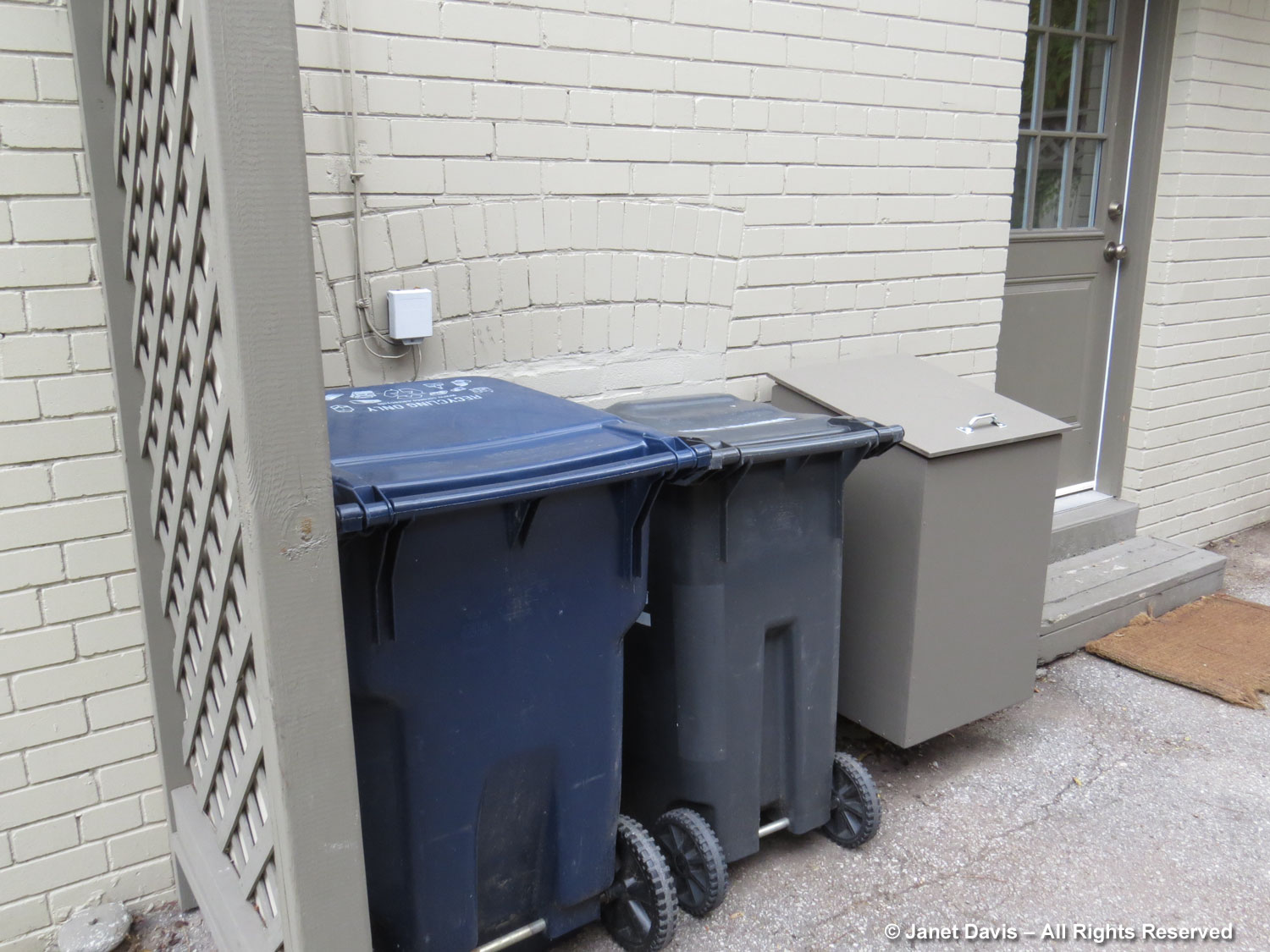
Meanwhile, the little sideyard garden grew and I learned which plants can tolerate living under a black walnut. Dry shade was a more important consideration, since the area is rarely watered except by rain and the tree sucks up much ground moisture. The shiny groundcover leaves are European ginger (Asarum europaeum); uber-invasive lily-of-the-valley, front right, makes its home there; and native Solomon’s seal (Polygonatum odoratum), front left, does very well, too. The tall shrub at left is alternate-leaf dogwood (Cornus alternifolia), my favourite native shrub and a seedling of one I planted in the back garden in the 1990s. The boughs of white cedar (Thuja arborvitae) come from my neighbour’s tree over the fence.
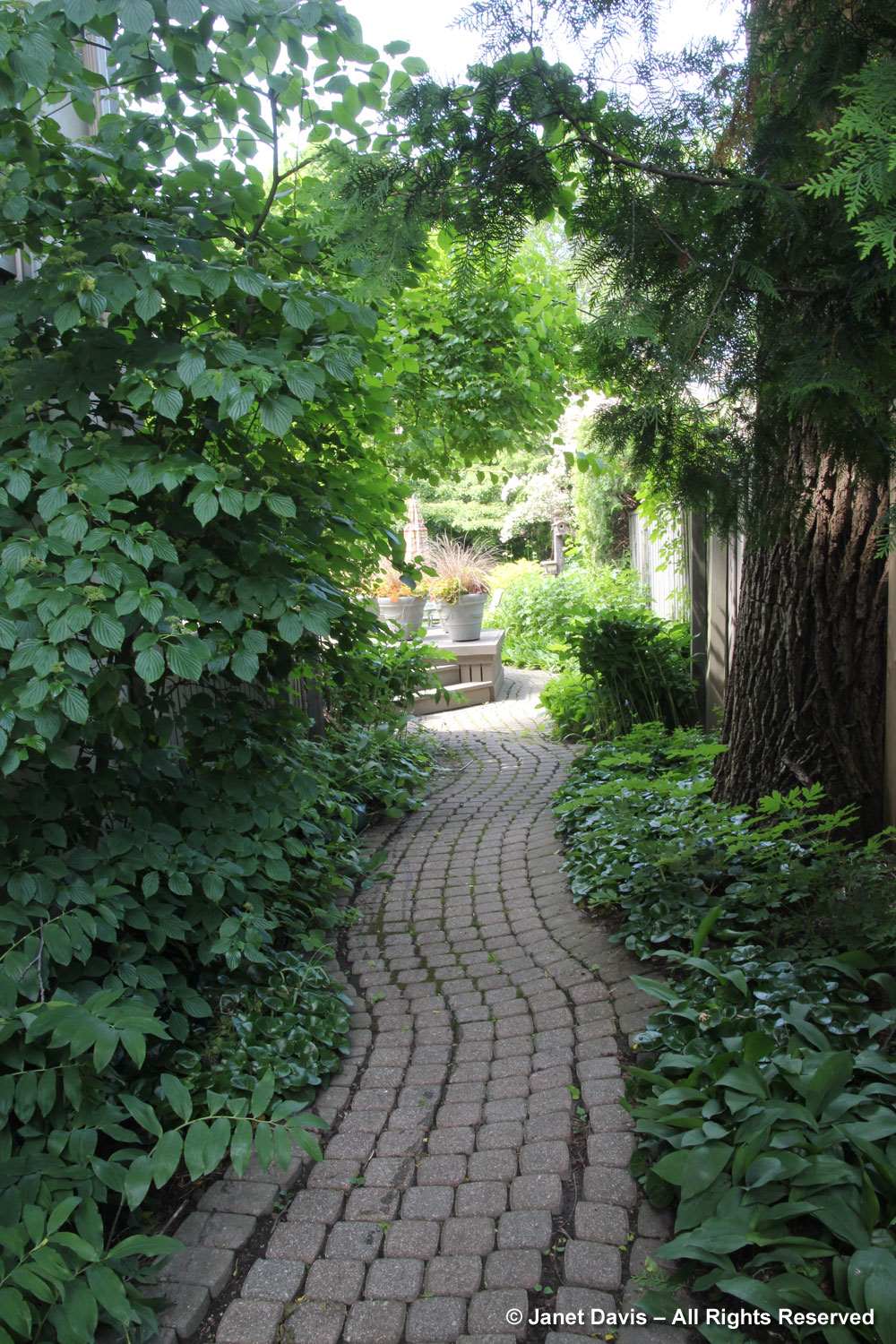
Here is the alternate-leaf dogwood in flower on May 22, 2012.
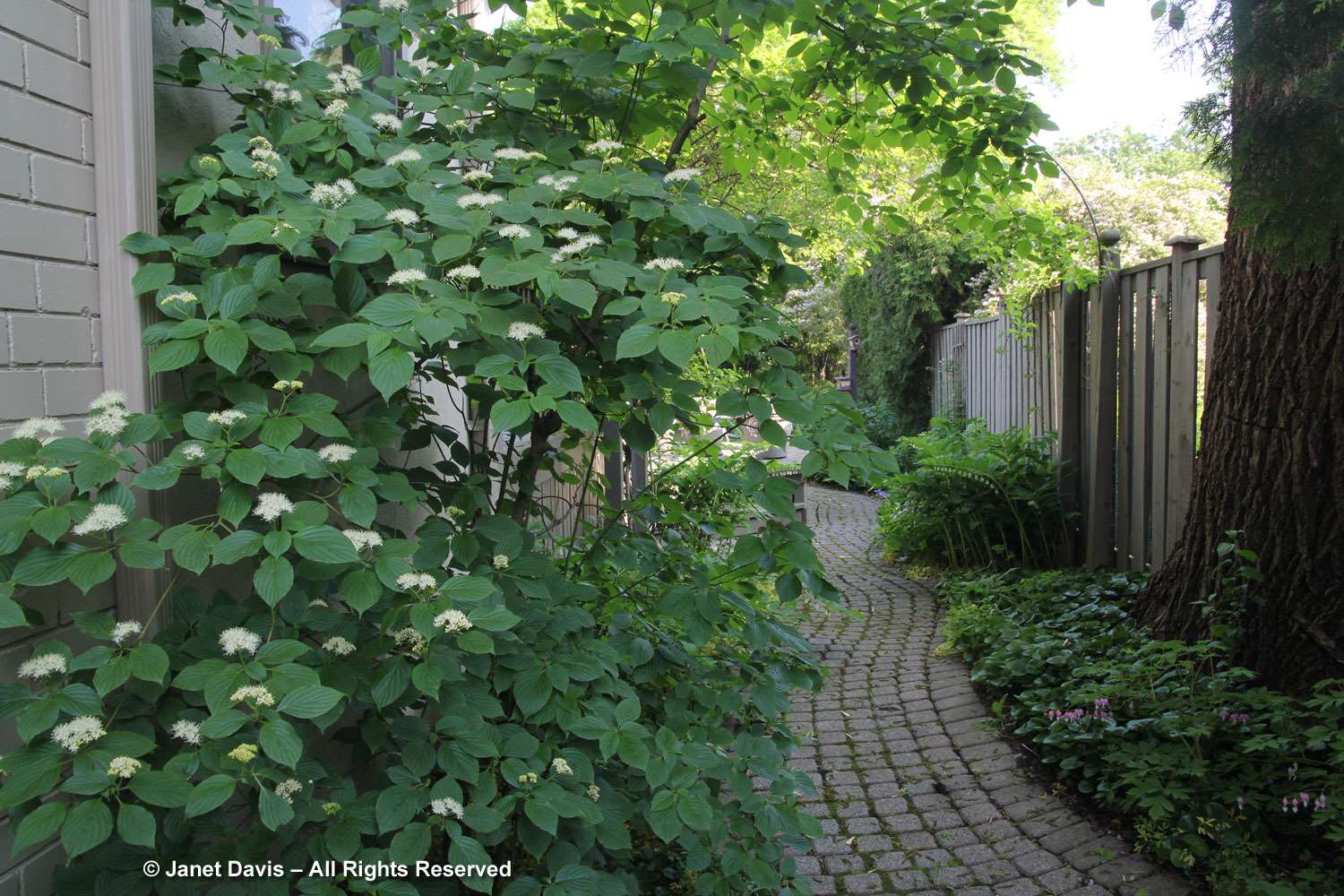
Move a little further along the path in this 2013 photo and you can see the double iron arch I installed atop 4×4 posts, over which I grew what I purchased as a native bittersweet vine but turned out to be the invasive Asian counterpart. The paver path circles around our lower deck to become a patio adjoining a lily pond in the back garden.
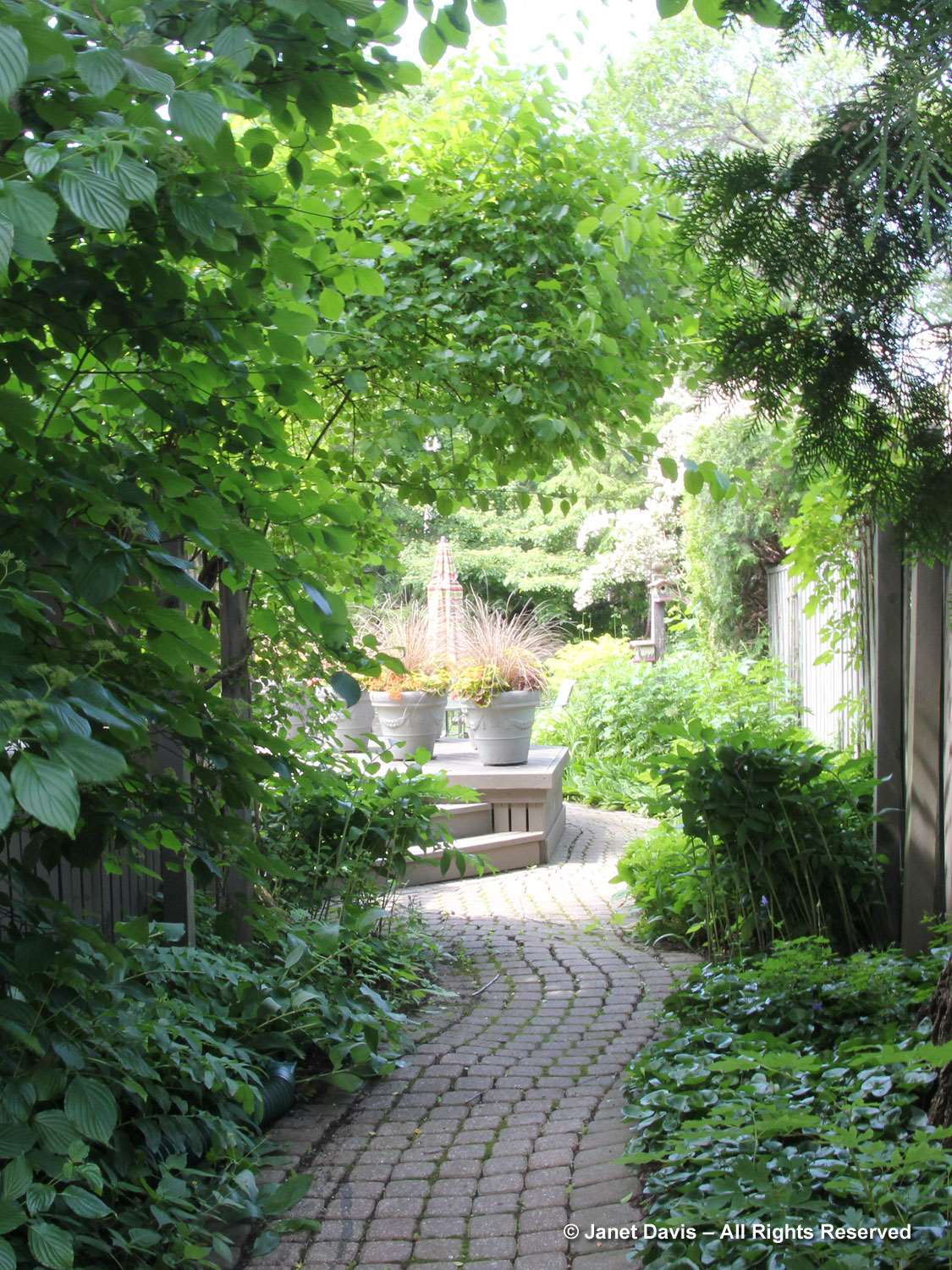
I planted a few bulbs of Corydalis solida in 2011 and they now carpet the sunniest part of the path garden in spring, but die away quickly as the Solomon’s seals send their green spears up.
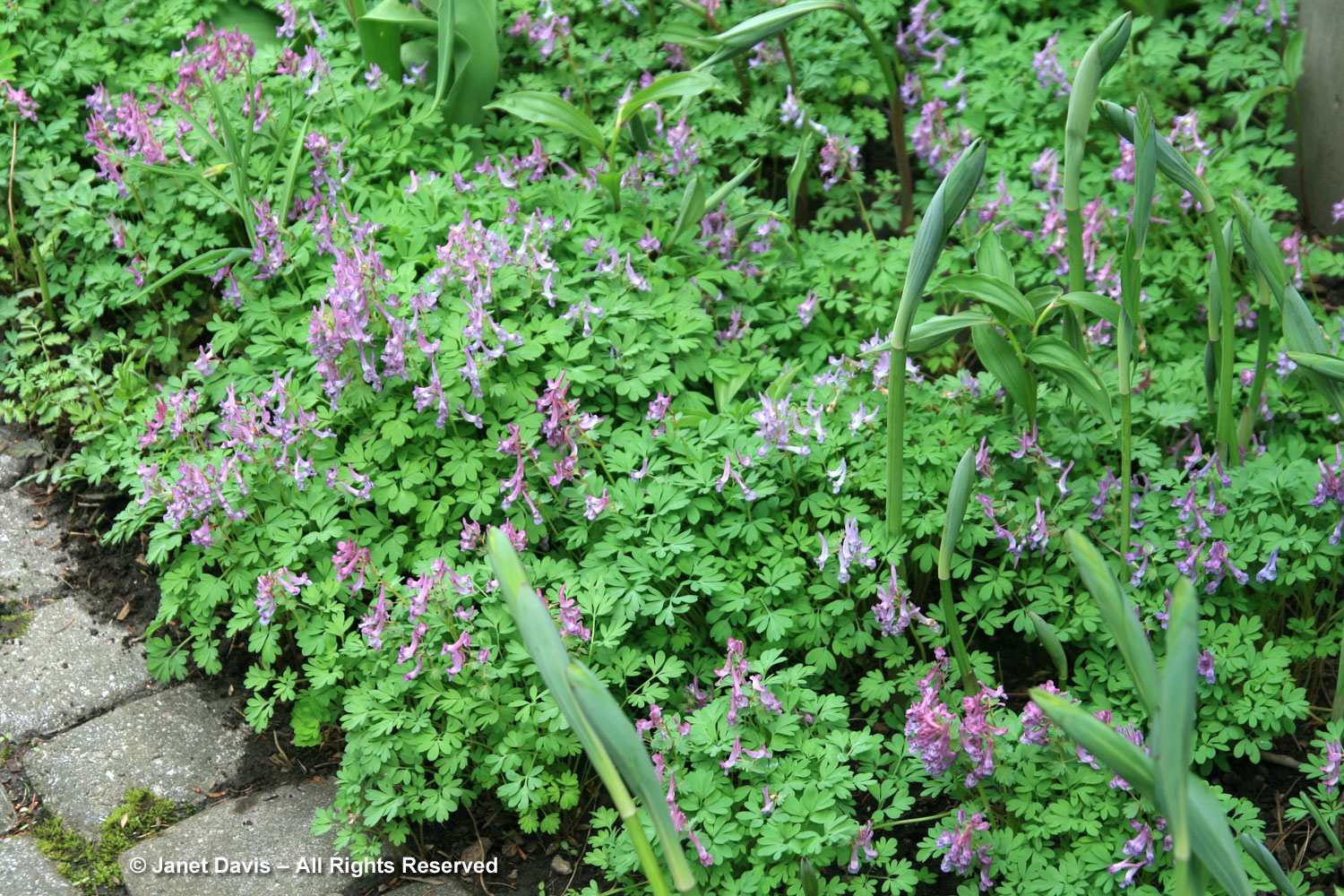
There are native spring ephemerals in the path too, like mayapple and Hepatica acutiloba, below.
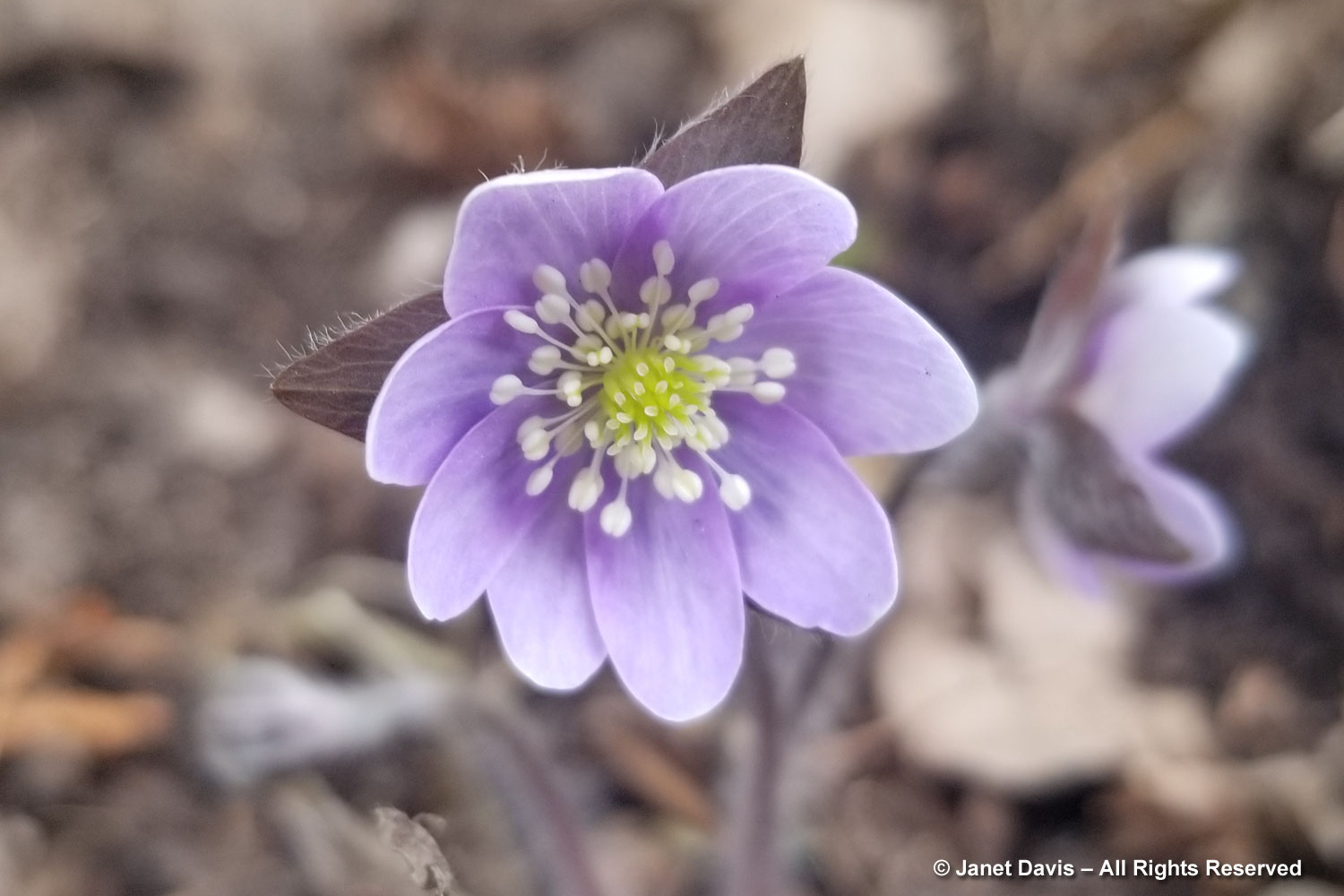
Lily-of-the-valley grows here, often in carpets – as it does in the rest of my garden. It’s always strange for me to see garden centres selling a few pips in a pot for $. I could be a millionaire, I think! Then I remember I’d have to dig them out, which is much easier said than done. But they are lovely in a little vase and they do make a very fun and fragrant garden party hat, as I’ve blogged before.
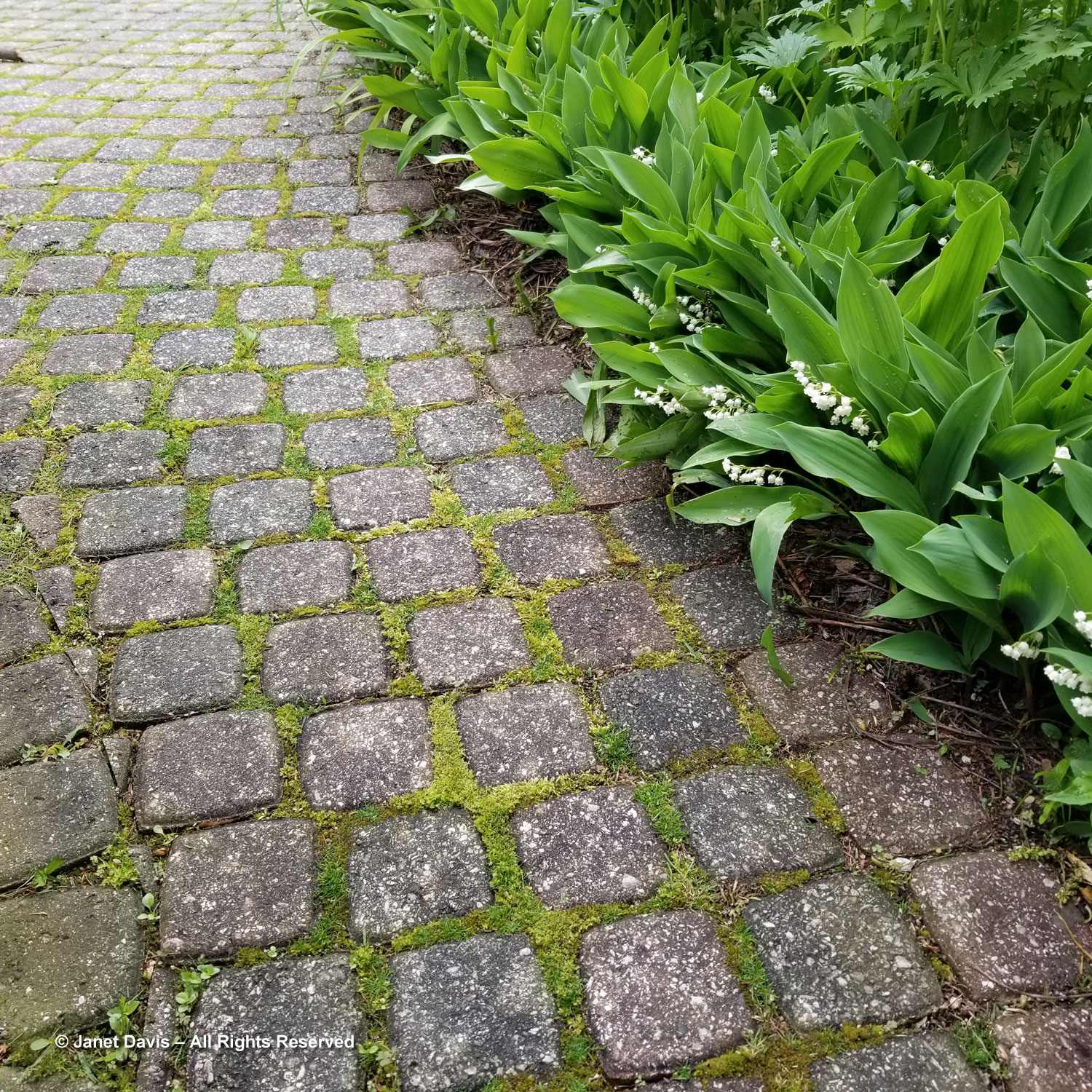
Here, looking towards the gate from the deck are the Solomon seals in a photo from May 24, 2016. Note the thick trunks of the bittersweet vine coiling up the posts.
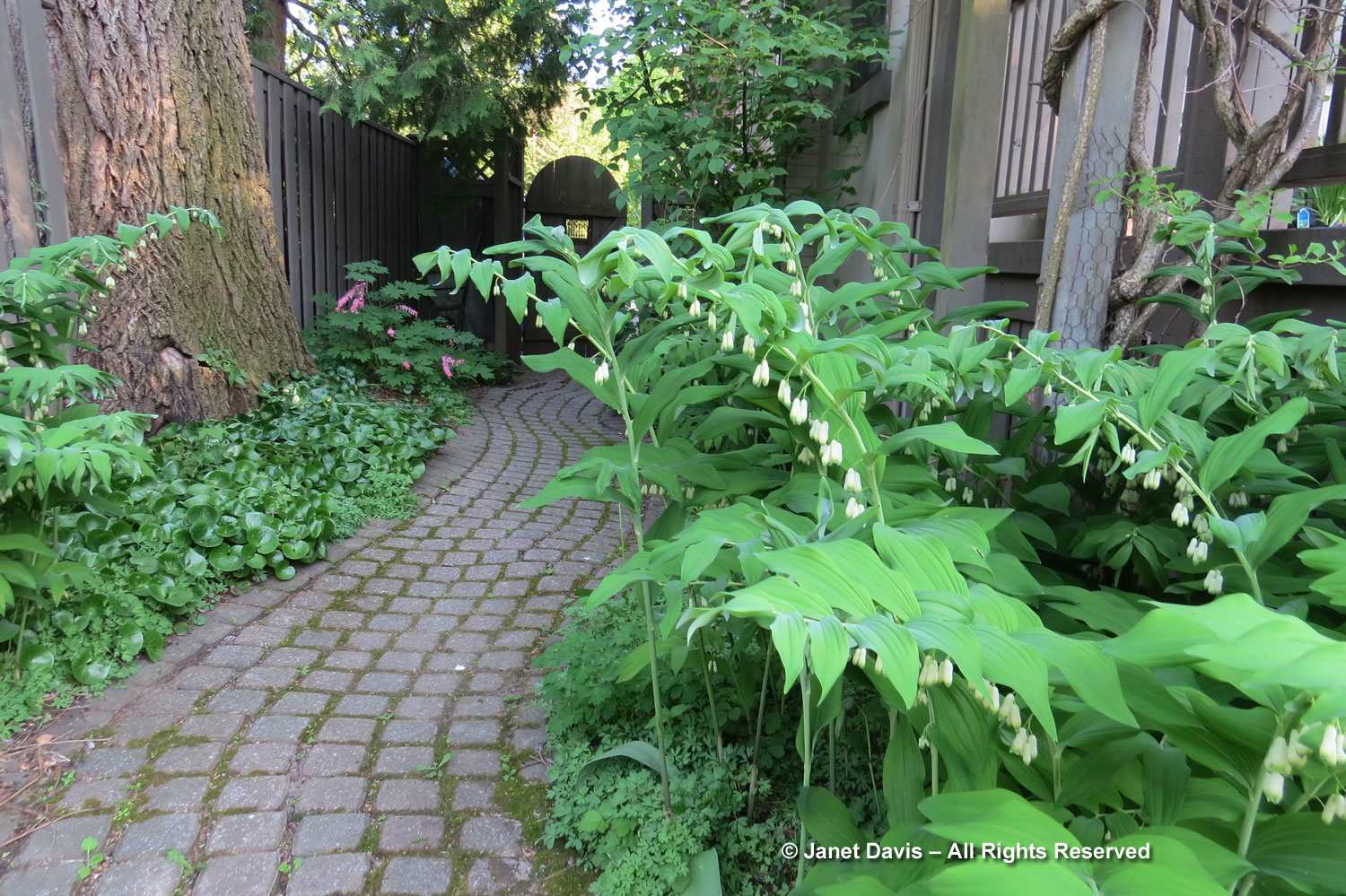
Just a little bit on Boston ivy, shown climbing onto the gate in July 2015. Because it adheres via adhesive sticker aerial roots, I’m never keen to let this invasive climb our house and attach to the old mortar. But I thought it might add some interest to the gate, so I’ve let it grow while keeping it trimmed.
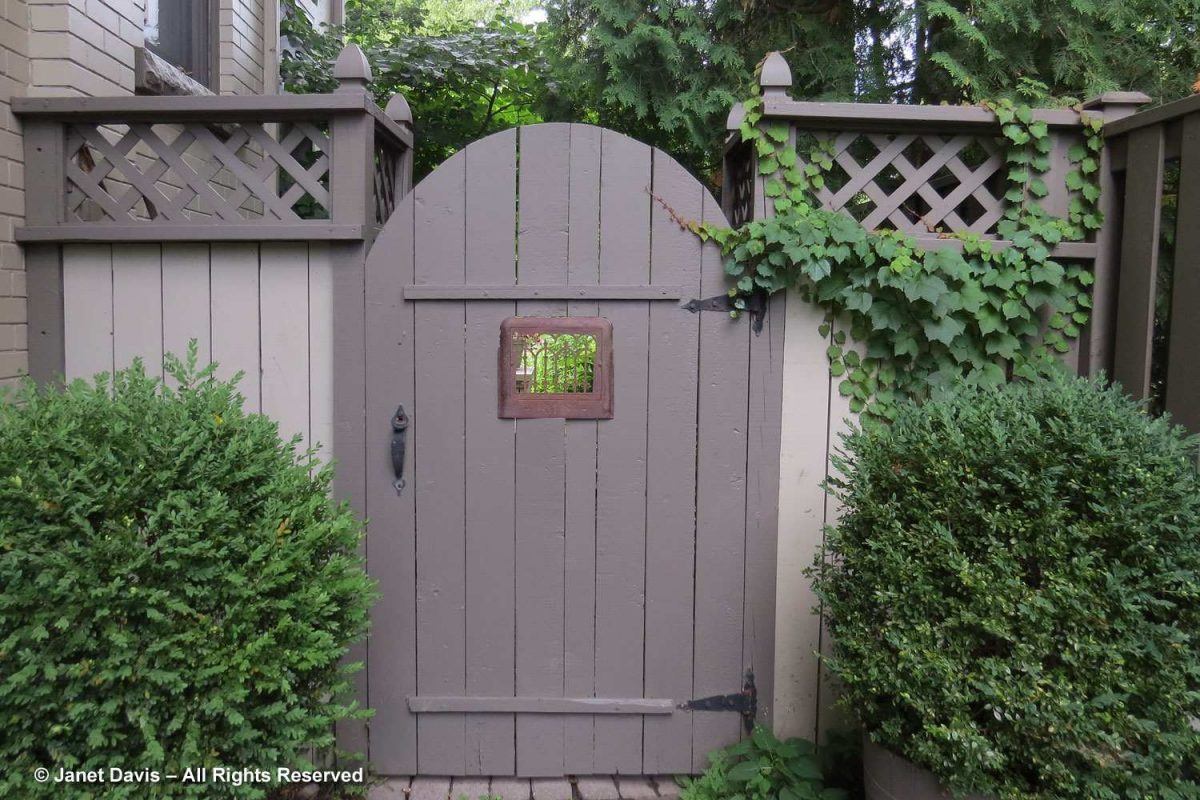
Inserting the see-through grate into the gate wasn’t an original idea; I’d seen various versions on garden tours. But knowing it had come from this house made it special – and I liked the fact that it lost its shininess and took on a rusty patina. It framed the garden beyond like a peek into a colourful jewel box.
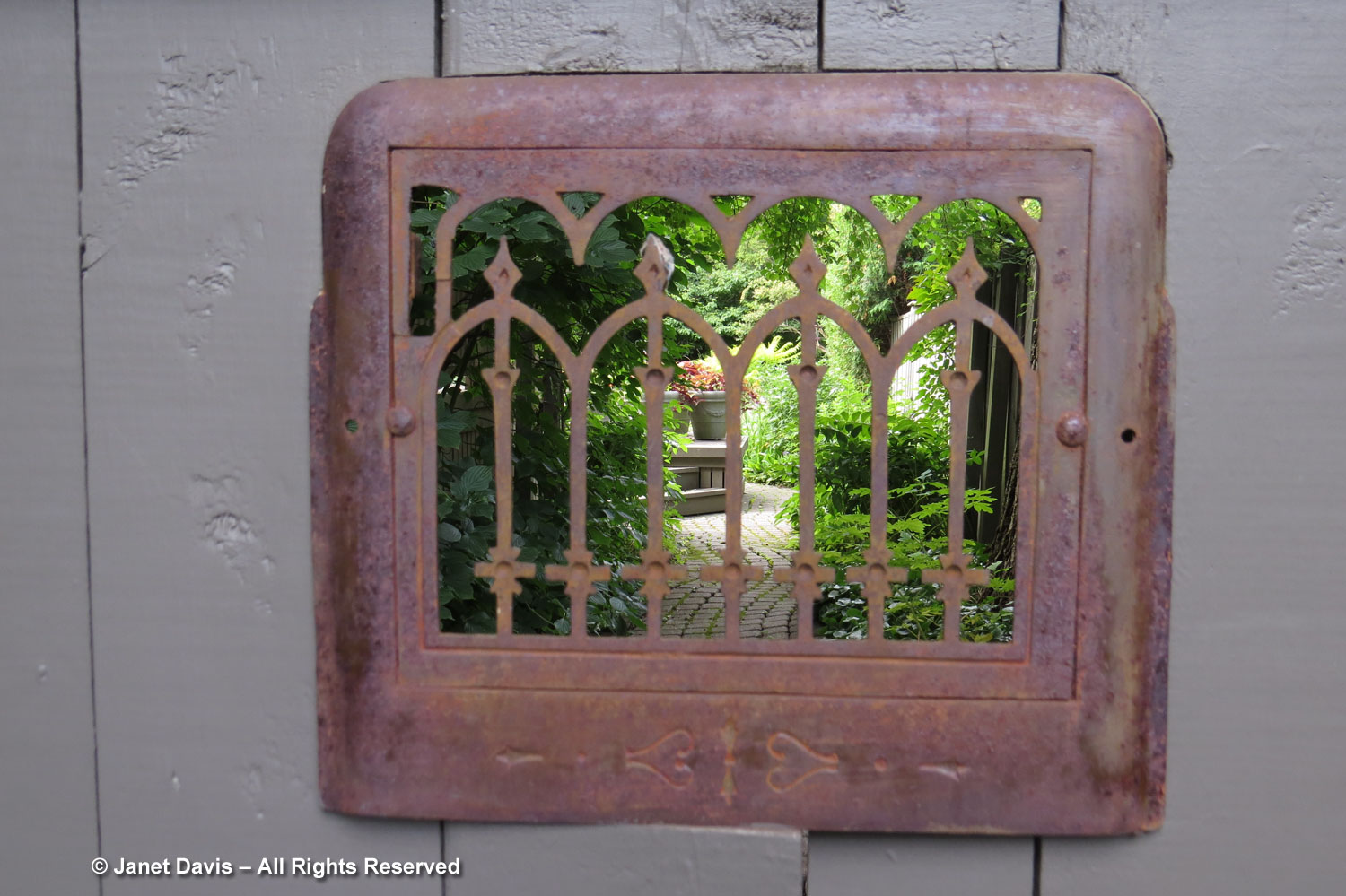
As the Boston ivy continued its journey across the gate on Oct. 16, 2019, I let its tendrils feel their way. In autumn it turned crimson, trailing across the view through the grate of orange sumac and azure blue monkshood and sumac at the back of the garden.
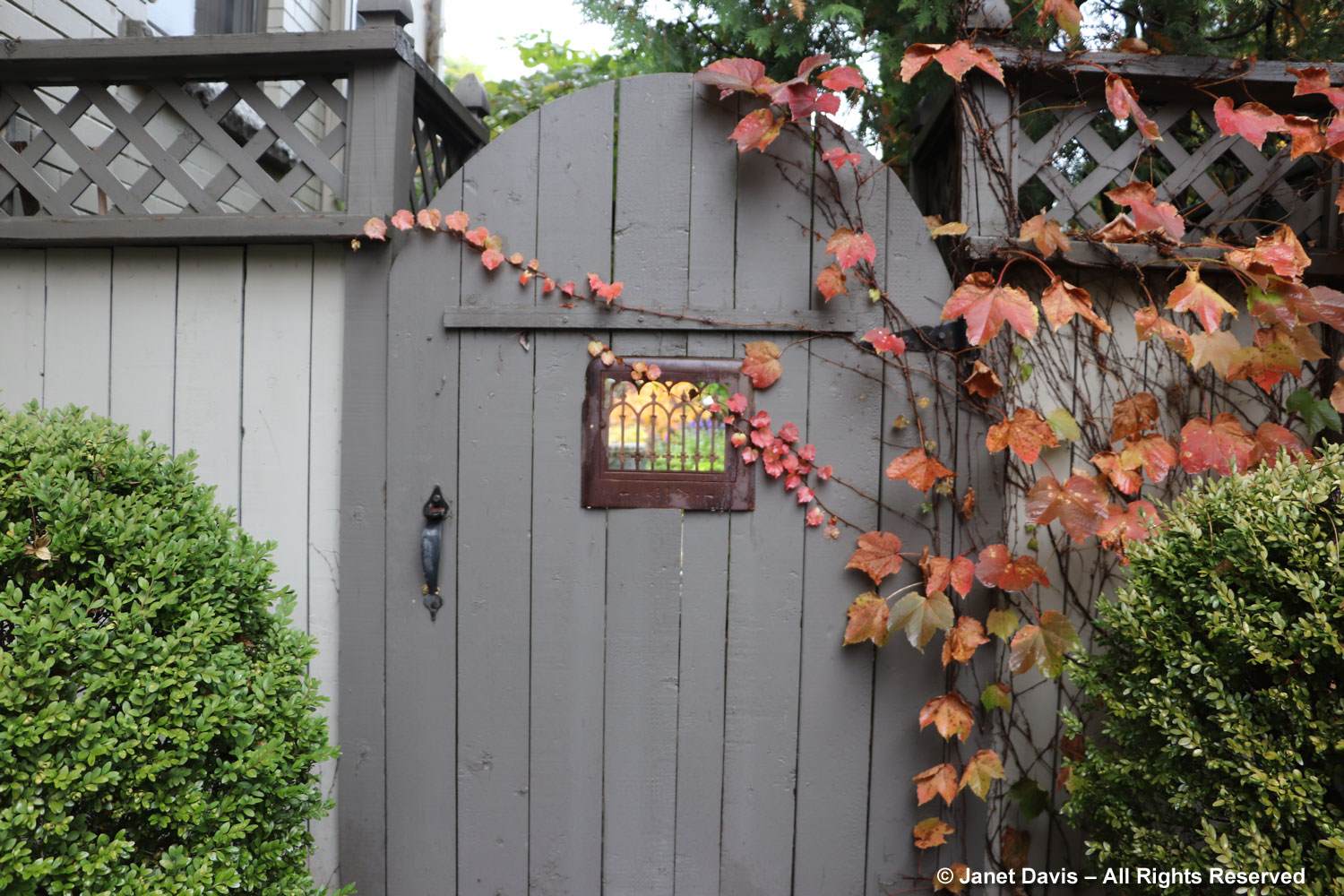
Here is the long view on that day, showing the path littered with yellow autumn leaves from the black walnut and the garden beyond.
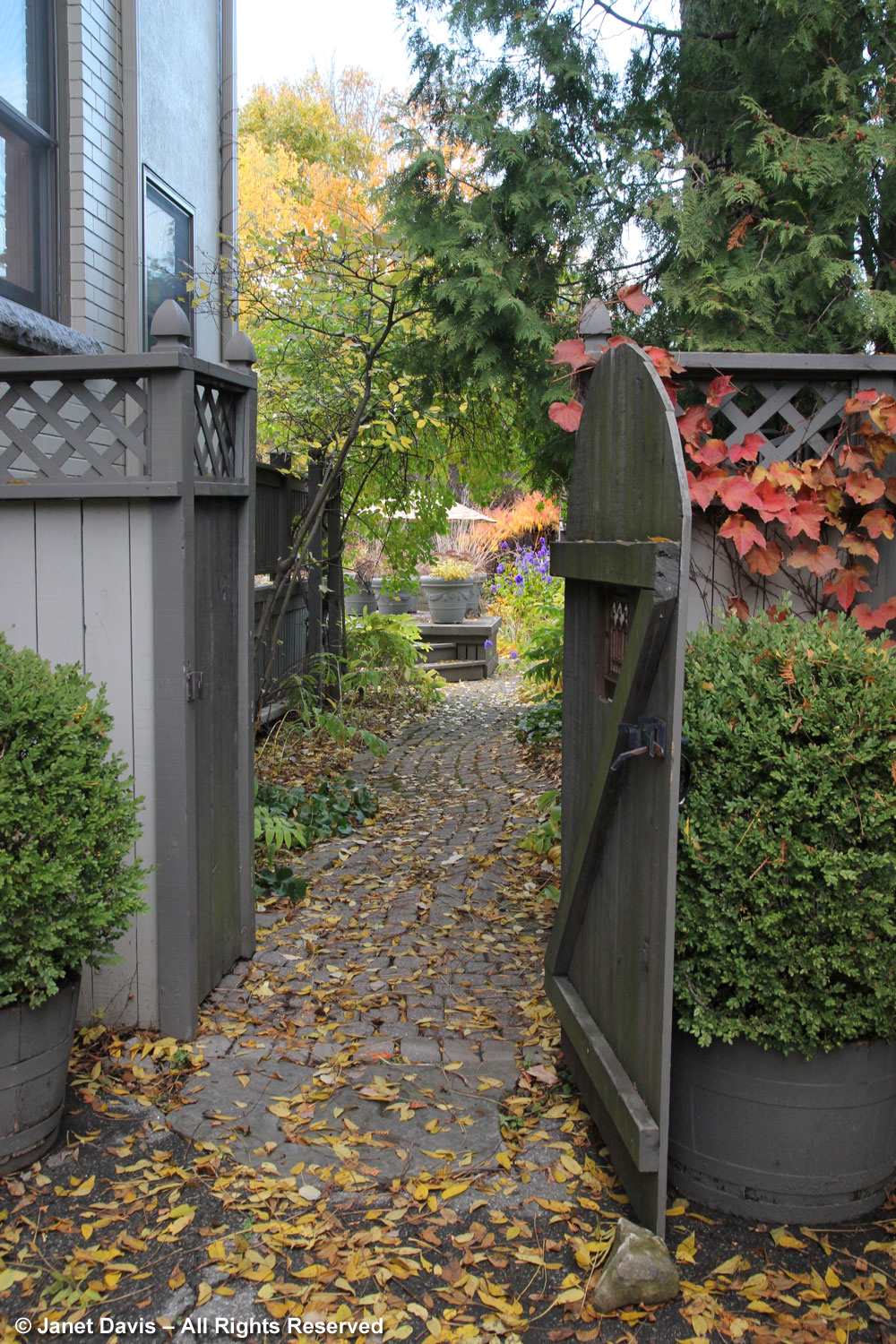
Notice how the juvenile probing leaves of Boston ivy are shaped very differently from the leaves on the older wood in the next photos. They’re almost heart-shaped….
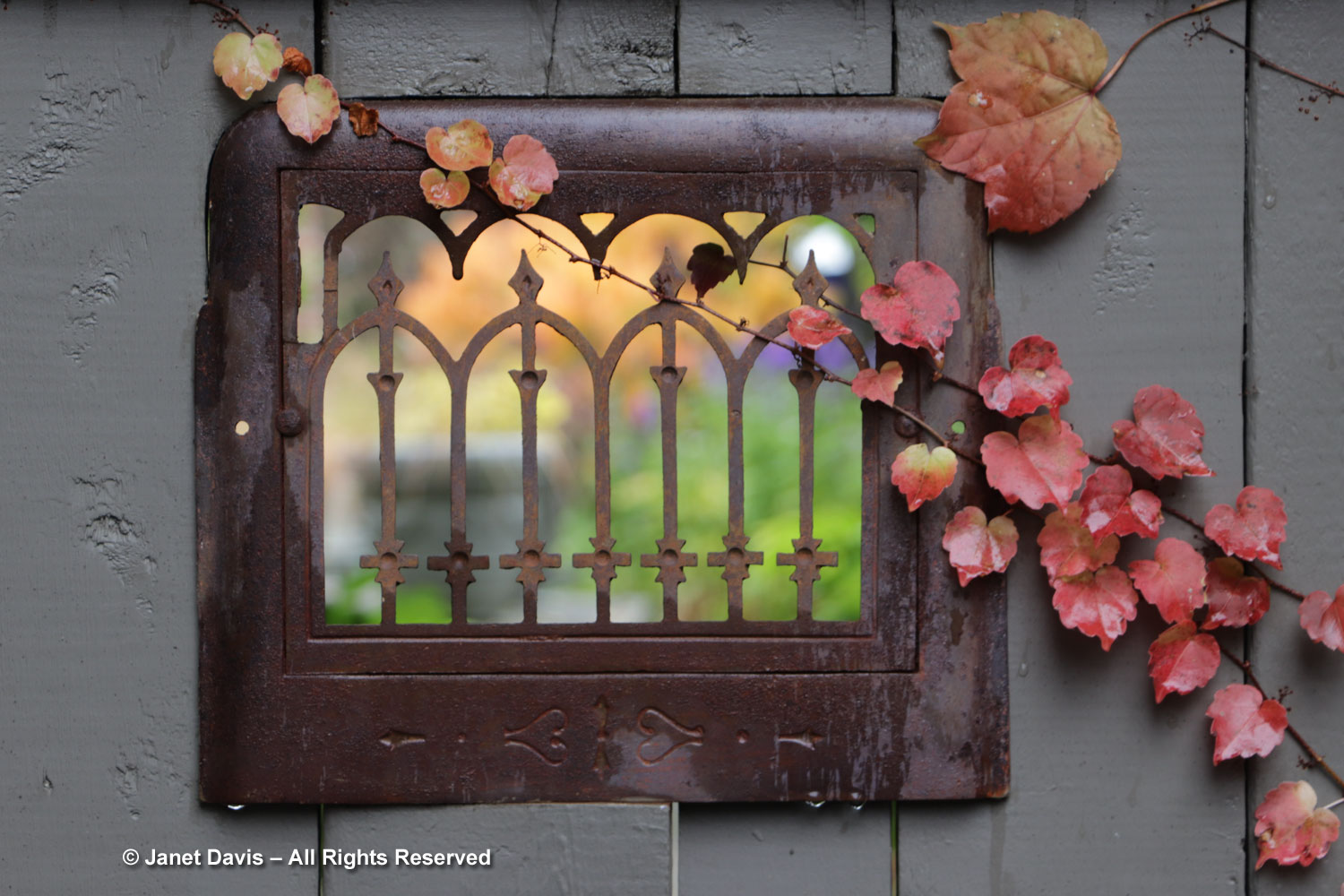
…. compared with the three-lobed (tricuspid) foliage emerging from the older wood in 2020.
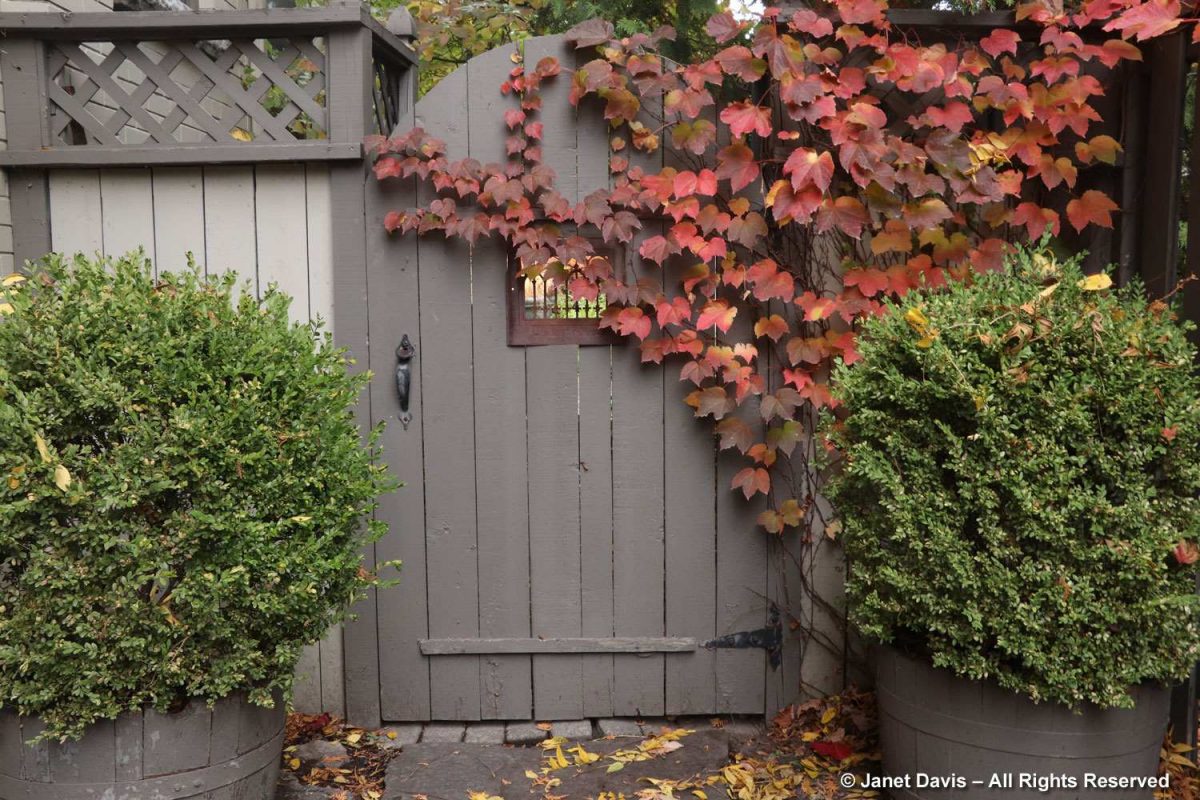
Boston ivy is one of the best species to show the effect of summer sunshine on the pigments of the autumn leaves. Where one leaf shades another, the shaded section does not turn red in fall, but reveals the accessory yellow photosynthetic pigments.
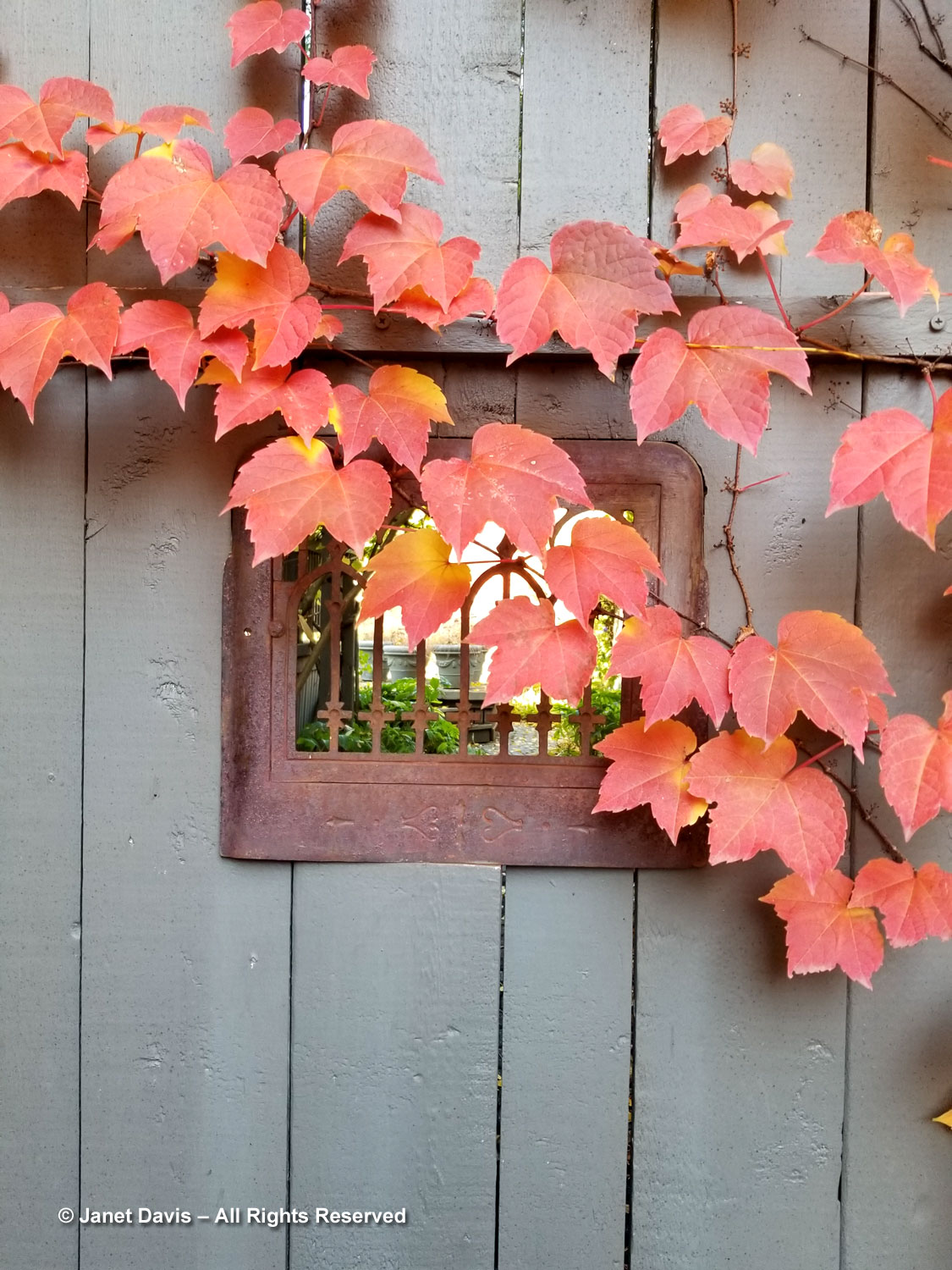
As the alien bittersweet vine grew across the iron arches, it framed the view to the garden in an intriguing way, but it also latched on to everything nearby, including the dogwood shrub and the house’s downpipes. I had to use a stepladder to try to thin it out and prune it away from both.
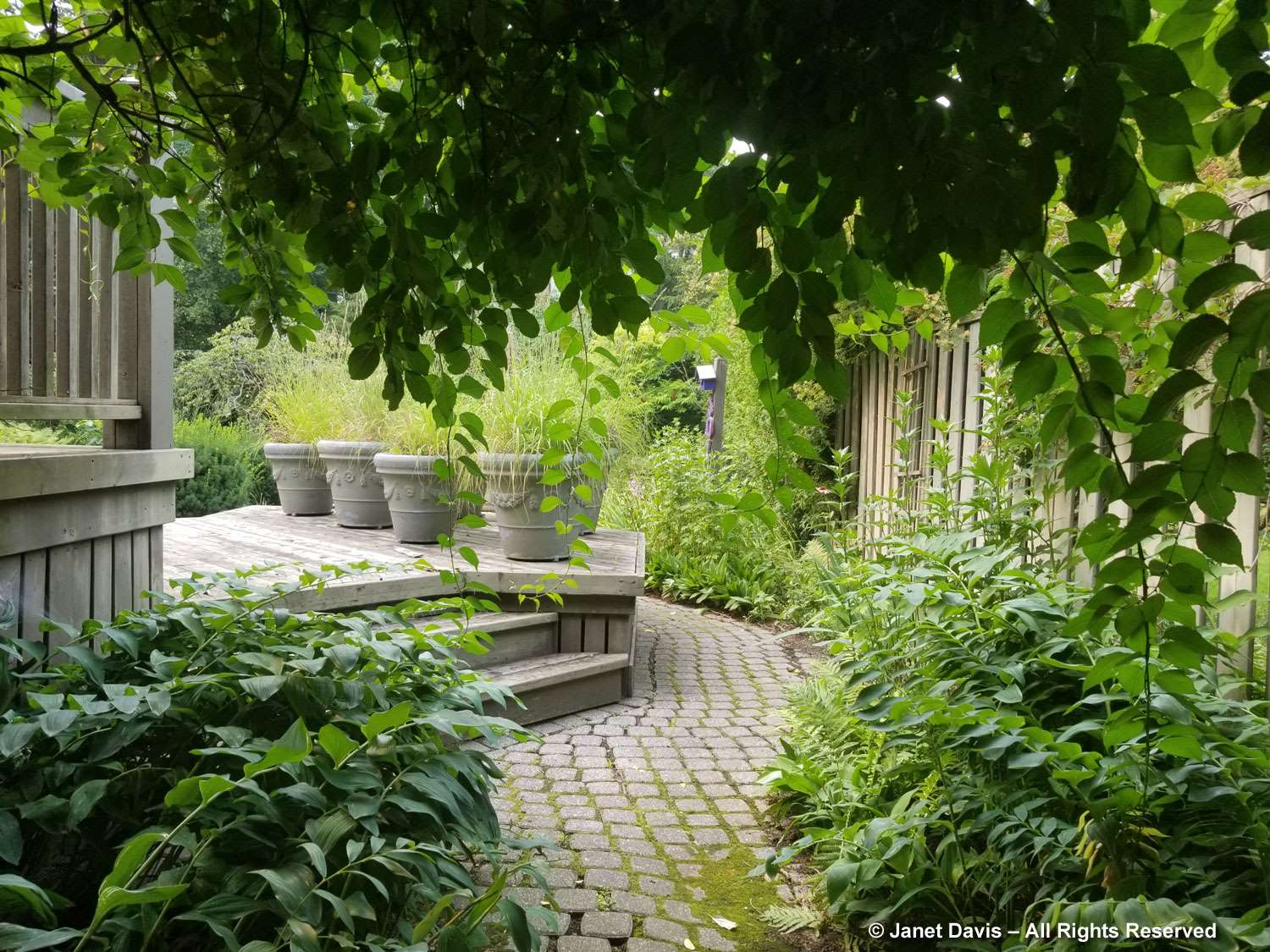
But I did love walking down the shady path in June to see my neighbour’s beauty bush (Linnea amabilis, formerly Kolkwitzia) in full flower over the fence.
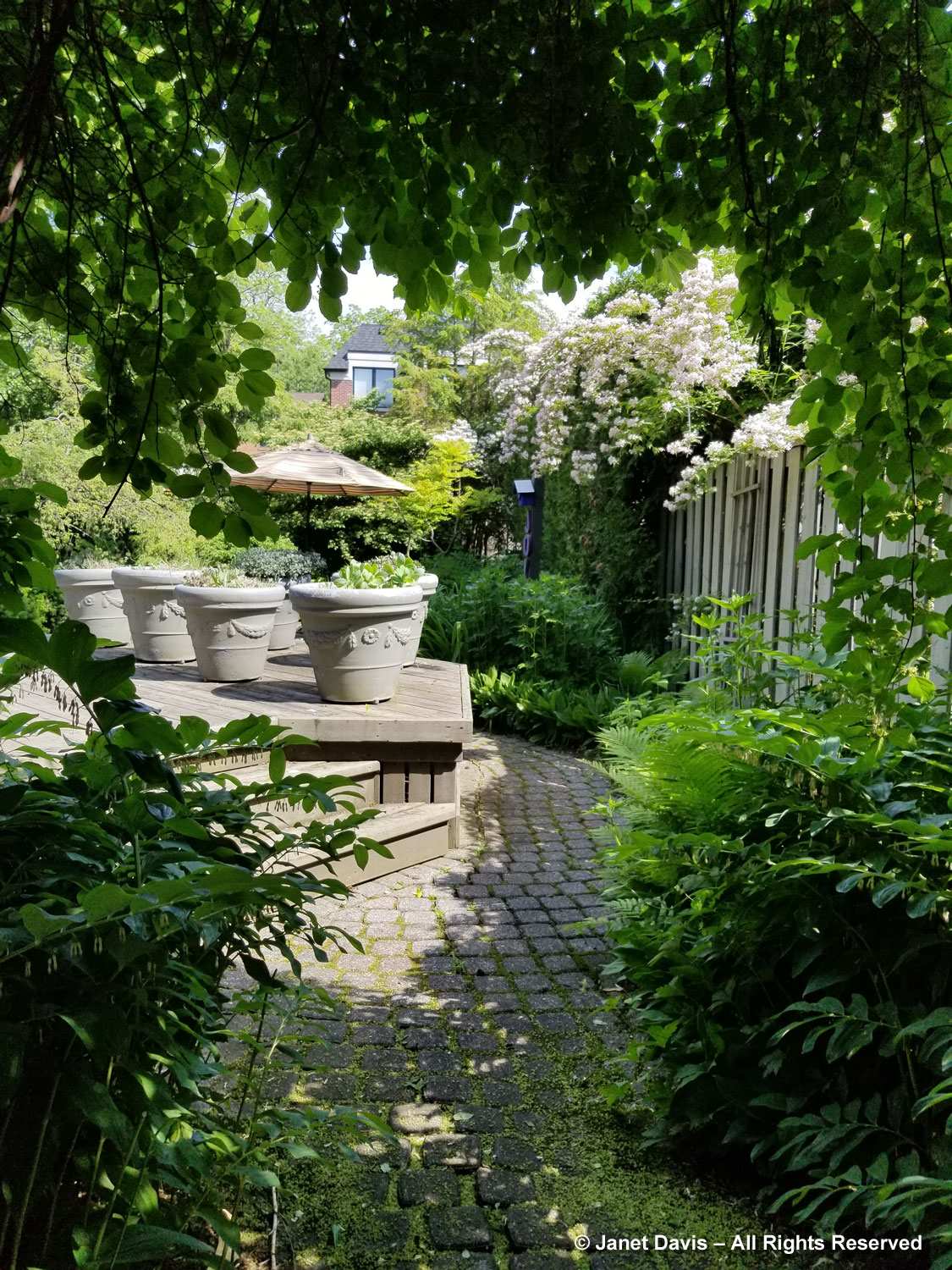
Alas, all that weight on the arches and the four old posts holding them up finally took its toll. The vine collapsed onto the path in summer 2021 and everything had to be chopped up, dug up and removed. (And this man was not too thrilled to be doing it.) But bittersweet doesn’t give up easily; every year it sends up shoots (some through the deck boards) from bits of root left behind, reminding us that it would like to return.
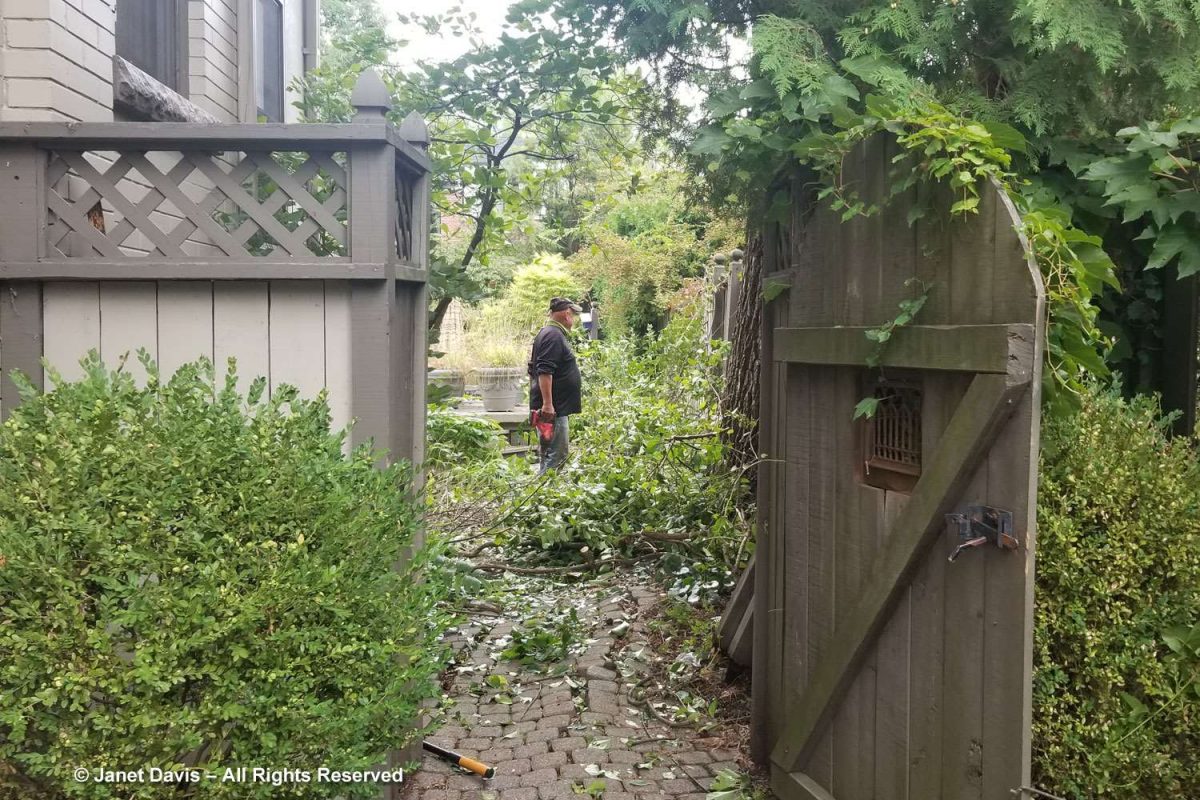
And that crack in the driveway? Eventually it opened, cracked more and formed more openings that turned into ankle-turning crevices. So the driveway had to be replaced in 2022. And with the old asphalt went the 1990 half-whiskey-barrels and the 30-year-old boxwoods, since it was impossible to work around them and the barrels had started to fall apart.
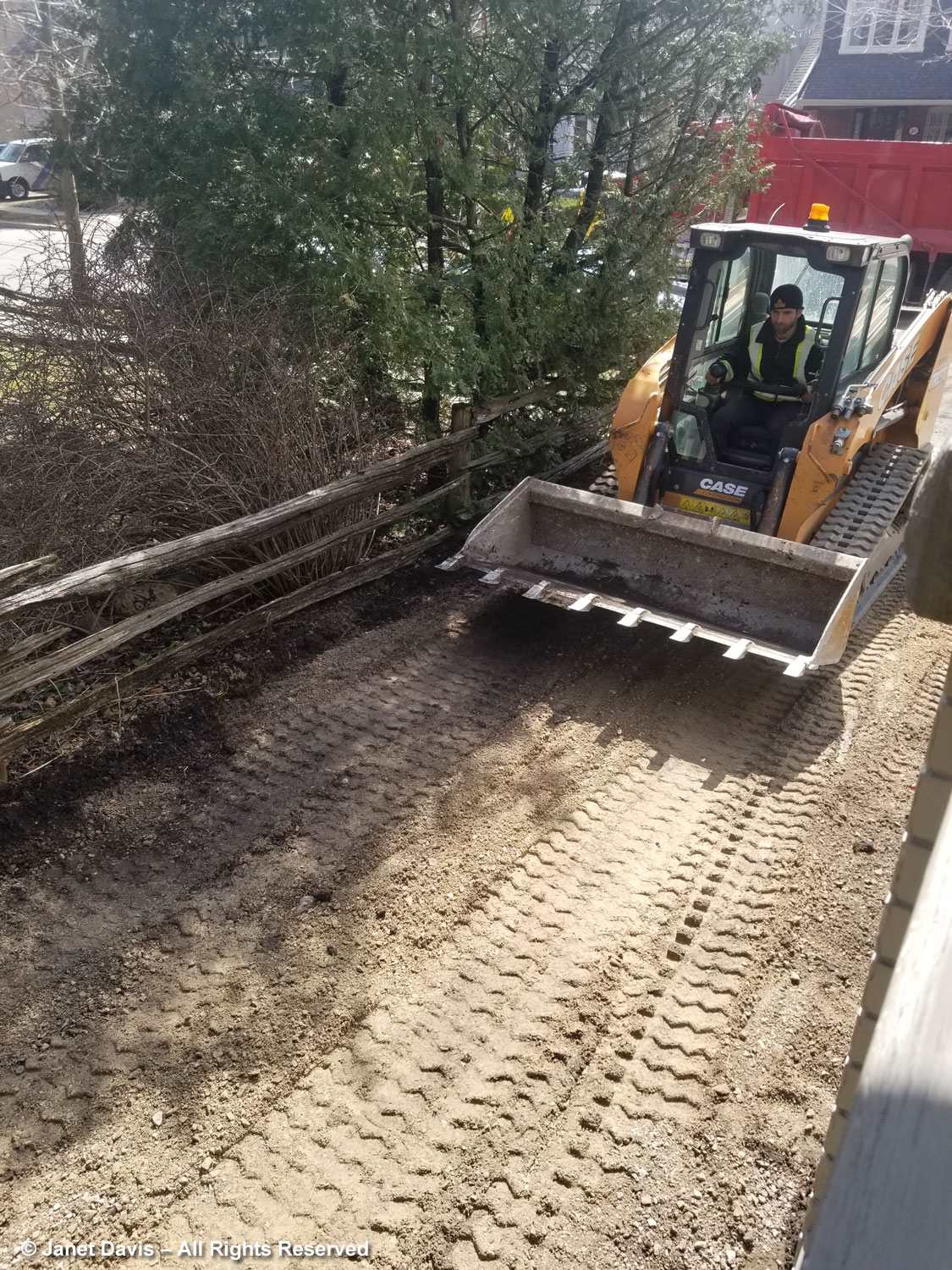
Surface roots from the black walnut had been lifting the path’s concrete pavers for years until they became unsafe and I had to warn visitors to watch their step coming into the back garden. I knew the time had come to fix the path.
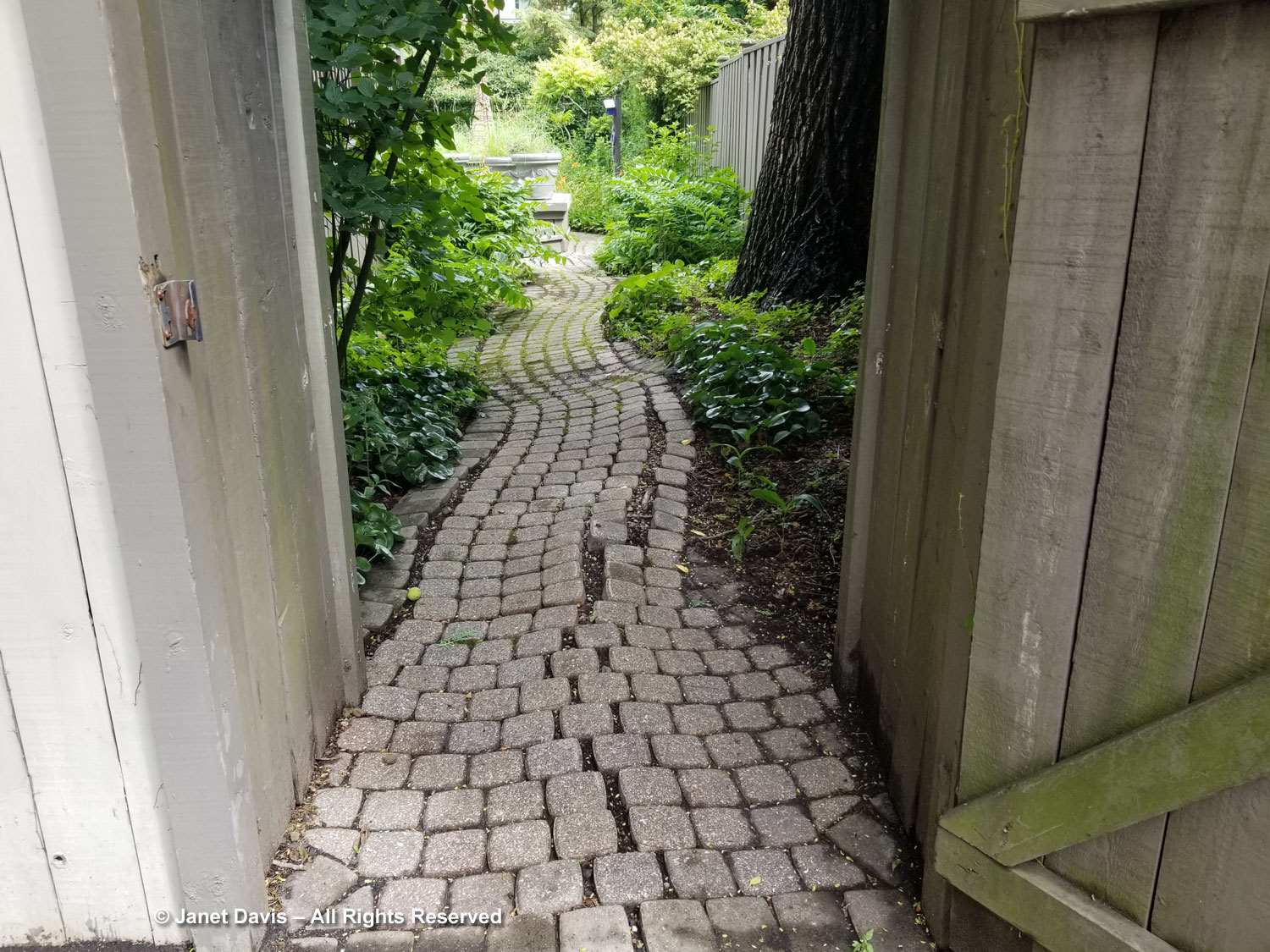
Black walnut is a tap-rooted tree, so the surface roots can take some cutting back before much damage is done to the canopy…
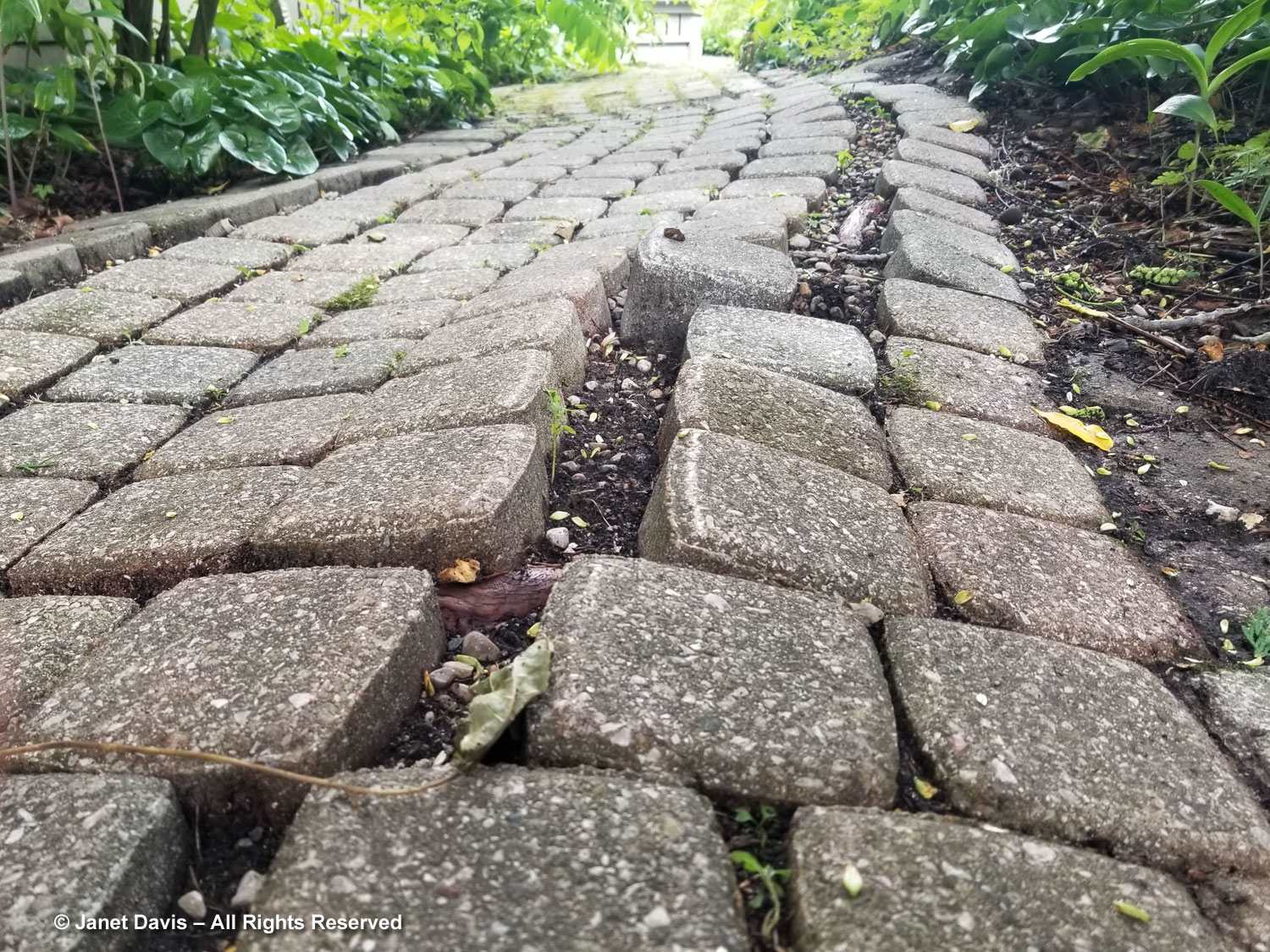
…. but the Toronto company I hired called “Leveled Ground” said they would not cut surface roots bigger than a “toonie”, about 1-1/2 inches in diameter. This offending root got cut.
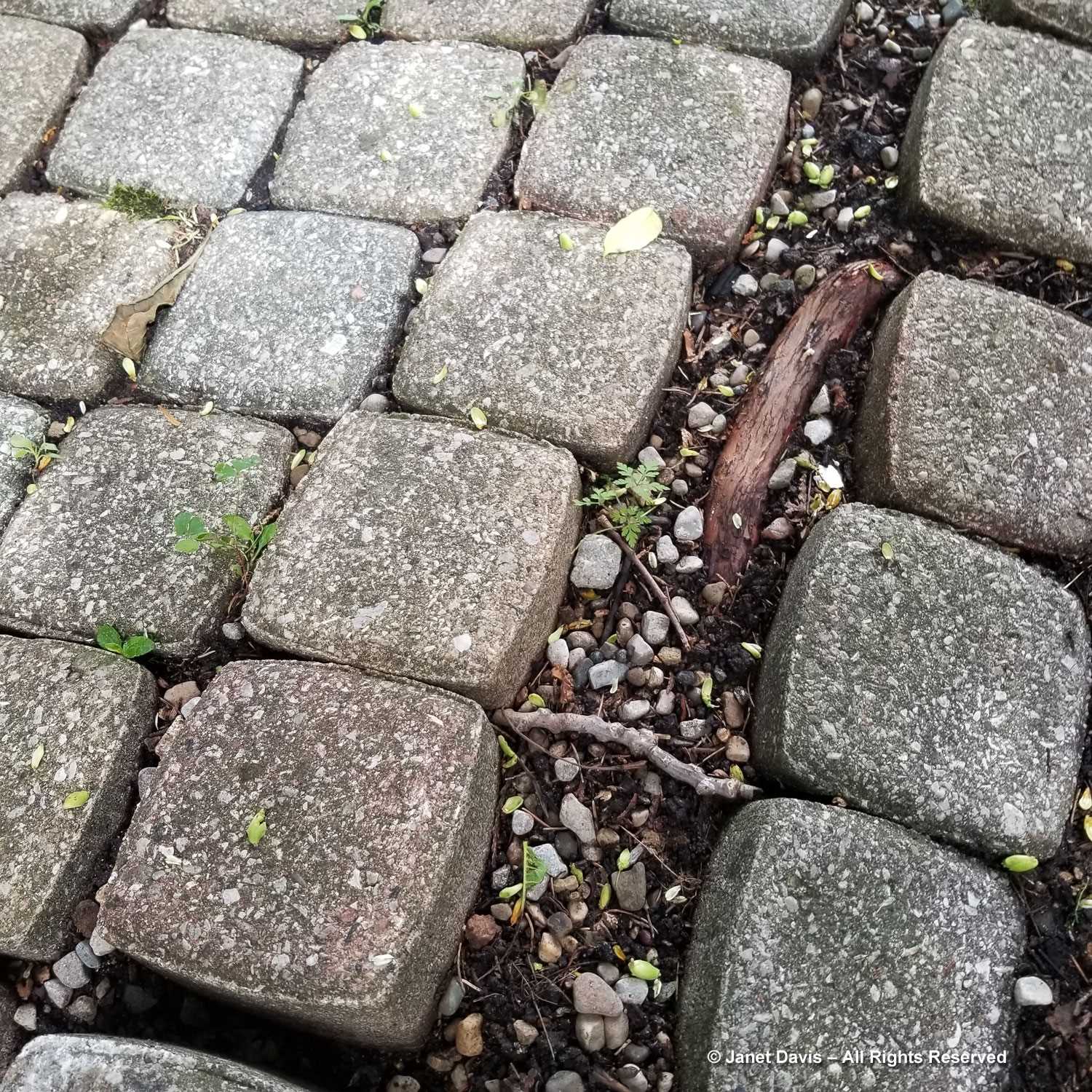
In July 2023, a team of guys arrived to lift up all the pavers….
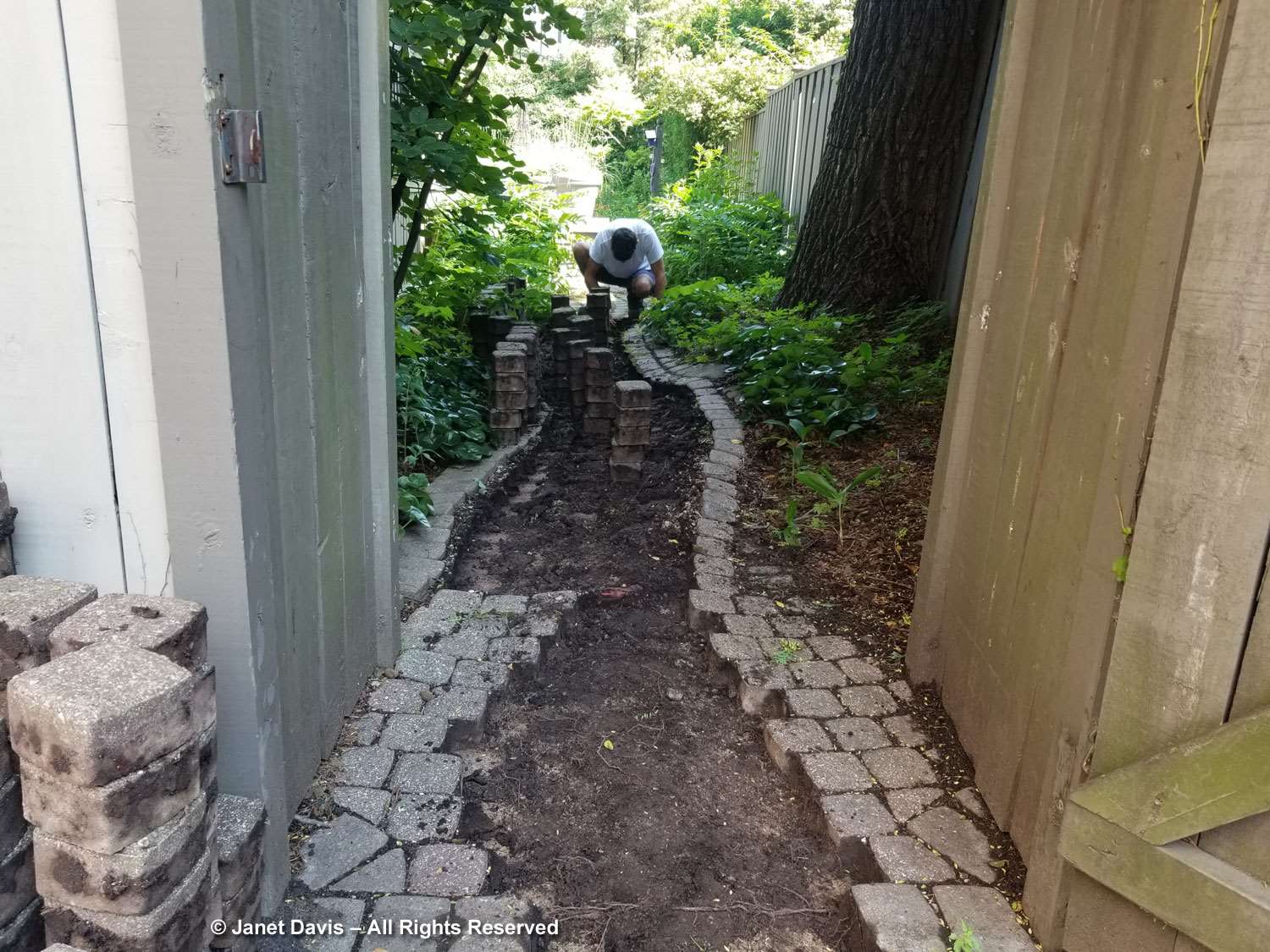
…. stacking them carefully in the new driveway.
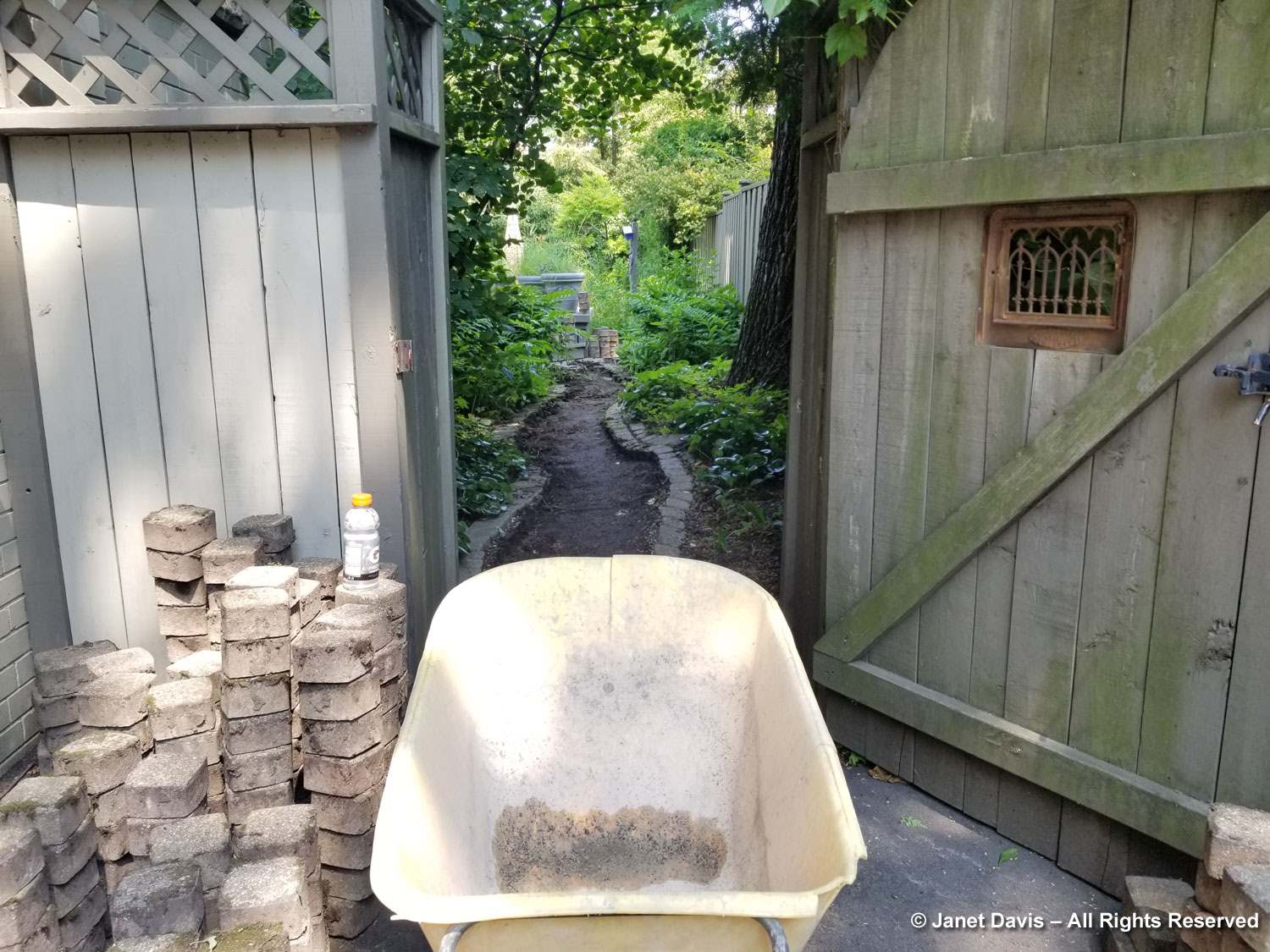
With all the pavers removed, they laid down a new layer of limestone grit, atop the layer put down under the old path in 1988, atop the layer from the original First World War driveway.
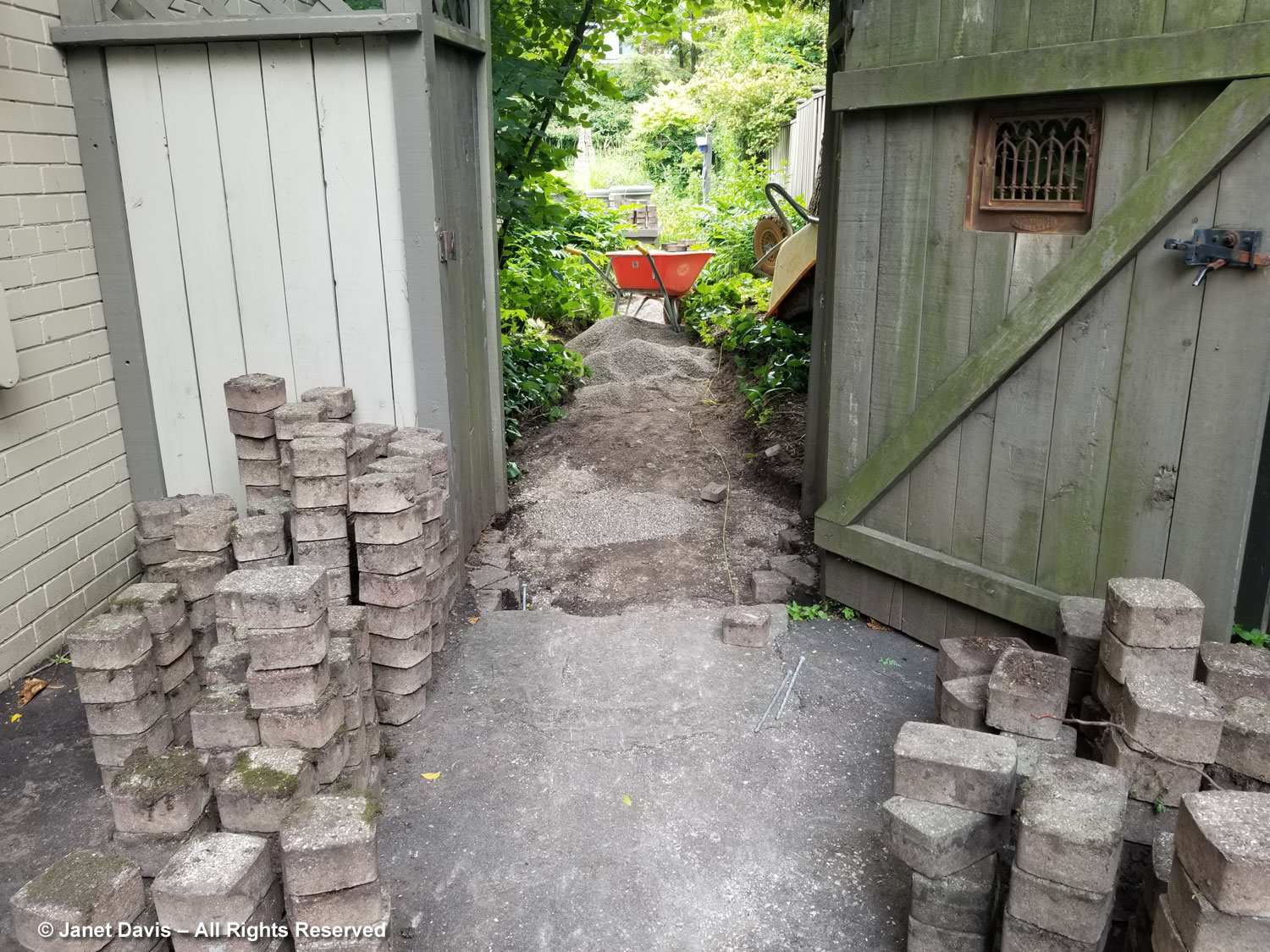
Now the right side of the garden under the black walnut is a few inches higher than the newly leveled path. After all the grit was laid down, they used a mechanical compactor to compress it, then put the old pavers back, adding sand between the cracks and using the compactor to compress the entire path again before sweeping it clean.
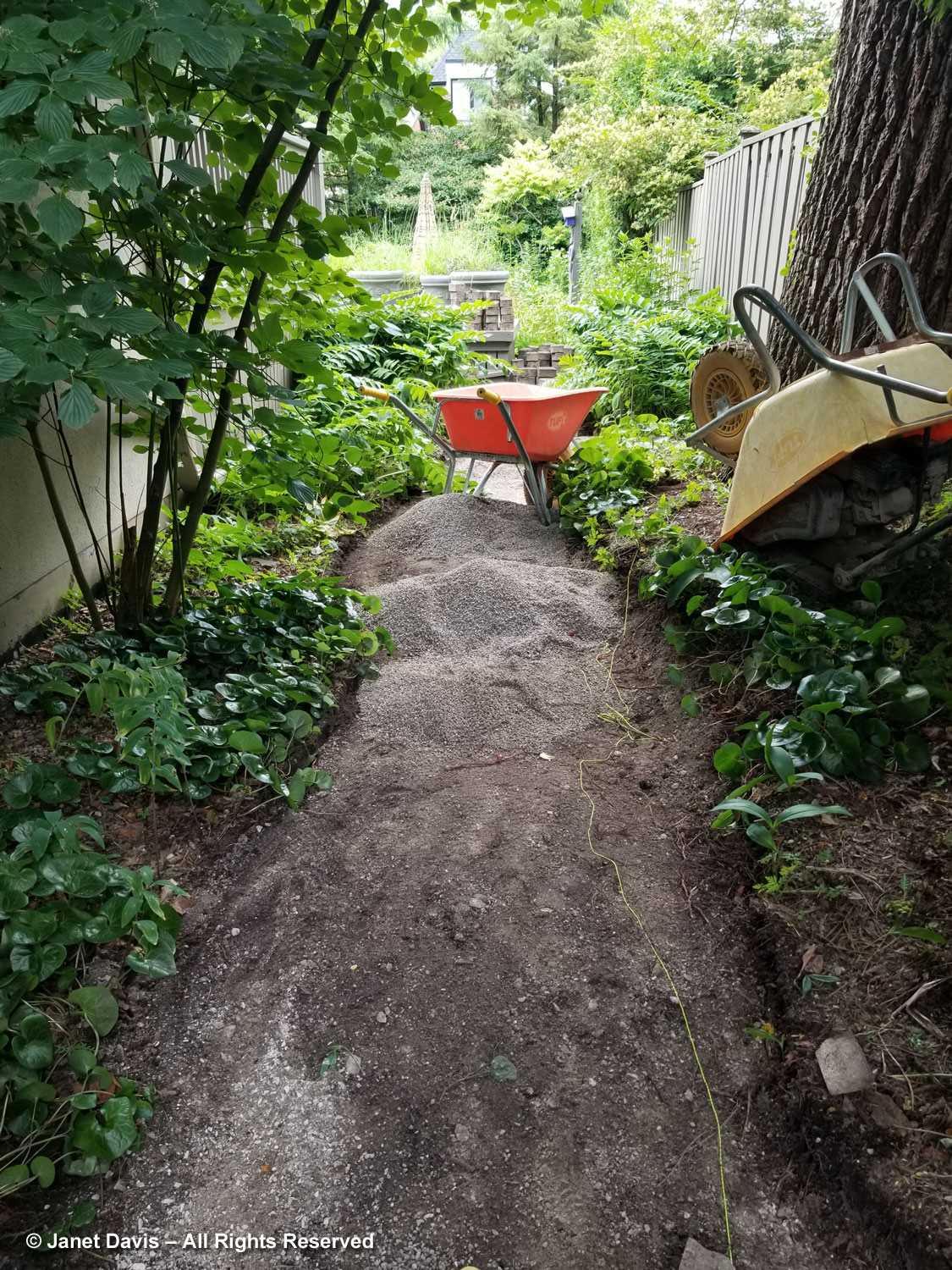
This is what the path looked like 2 weeks after Leveled Ground departed. Sturdy, flat and safe.
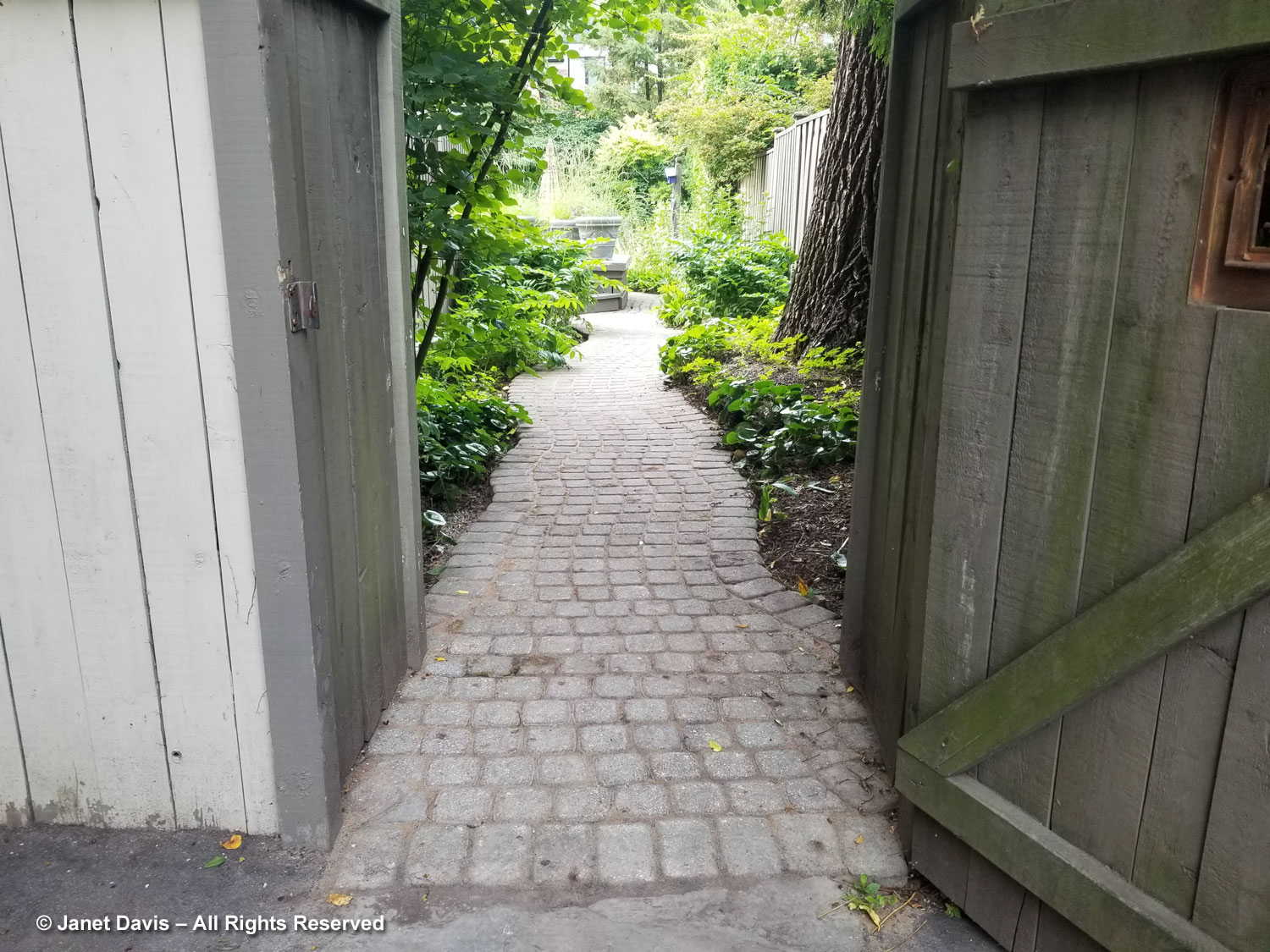
I’m not sure how long the old black walnut will last. For that matter, I’m not sure how long we’ll last in the house – many of our friends have opted to move into condominiums as they’ve aged. But I cannot imagine life without a garden, watching birds drinking in the pond, bees nectaring on flowers, leaves changing colour in autumn – and that old gate leading down the curving path to the joys beyond.

Such a great post, Janet. Our gardens, and their hardscape, are always changing, I love your pathway! So glad it was reinvigorated.
Thank you, Lisa. I suddenly thought, so much about my garden has changed in terms of the plants, but the pathway has been a constant (well, a constant in need of attention) and deserves a blog. Best of luck with your Quebec book!
The grid in the gate – both the enchanting glimpse, and that it carries your house’s history – is wonderful!
Thank you Diana! Yes, it has always been a fun little detail. It’s hard to photograph however, since either the garden or the grate is in focus, not both.
Wonderful post Janet. Loved reading the story of your garden. Nor can I imagine life without a garden o I’m staying put.
Thanks, Donna. I know this spring will be a hard one for you, but our gardens have the power to soothe us.